16 Ancient ROME Sites & Roman Landmarks to See in Rome, Italy (+Map)

Ancient Rome – the civilization dating from the founding of the city of Rome in 753 BC until the collapse of the Roman Empire in the 5th century AD – has had a big influence on the world. It has inspired and influenced so many generations and continues to do so today…
No matter how many books you read and how many movies you saw, there is no better way to get acquainted with this fascinating culture than by visiting some of the ancient Roman landmarks in Rome, Italy!
In this guide, you can learn about the best Ancient Rome sites that you can still see in Rome today. Some of them – such as the Pantheon or the Colosseum – are world-known and are among the most popular places to see in Rome. Quite a few other remaining Roman landmarks are lesser-known and could be qualified as the hidden gems of Rome, often overlooked by tourists… But they are all worth seeing!
Whether you are fascinated by the Ancient Rome civilization, are interested in antique Roman architecture, or simply want to see some of the most impressive Roman landmarks and learn the stories behind them, this list will give you a good idea of the places that are worth visiting the most.
To help you plan your time, we also created a map indicating the best Ancient Rome landmarks in Rome. You can find this map at the bottom of the article.
Even if you just visit a few of these landmarks, you’ll appreciate so much better how special and unique Rome really is. It’s not for nothing that it’s called the Eternal City.
READ ALSO: Where to Stay in Rome (the BEST Area for First Visit)
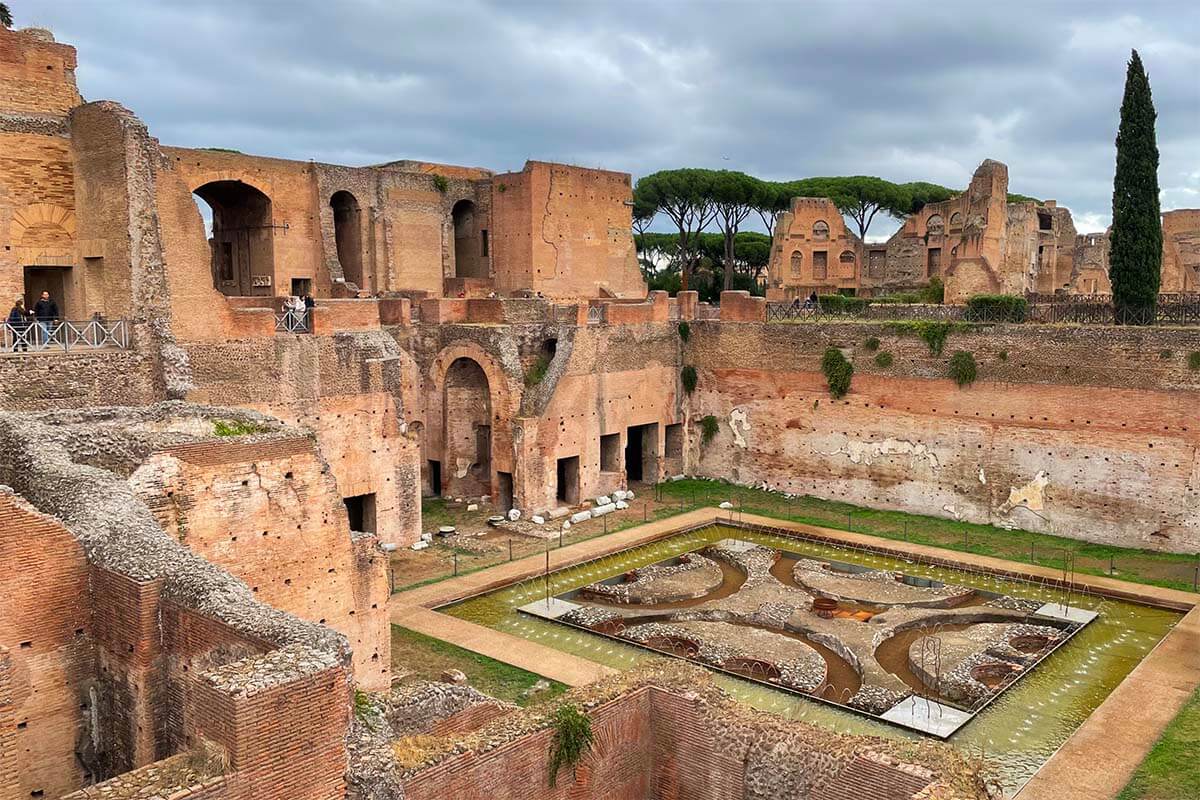
Good to know: Please note that in this guide we only mention some of the best-preserved and most important Ancient Rome landmarks that are located in or just near the city of Rome.
We also tried to sort this list by age, starting with the oldest Roman landmarks first. However, it’s not always possible to determine the exact dates. Furthermore, some archeological sites contain more than just one building (each dating from different periods), and others were built and rebuilt or their development spanned over several centuries…
So the timeline is only meant to give you an idea of how Ancient Rome developed over the centuries. It should give you a better insight into how old and unique these antique Roman sites really are. Take a look!
Here are some of the best ancient Roman landmarks you can see in Rome today:
1. Palatine Hill & Roman Forum
The origins date from around the 10th century BC. Some of the oldest Roman temples (7-8th century BC) were located in this area as well.
The Roman Forum (Forum Romanum) and the Palatine Hill (Palatino) are among the oldest places in the city of Rome. It’s in this area that you’ll find most of the ancient Roman landmarks; too many to even try to list them here…
It’s believed that the founders of Rome – Remus and Romulus – were nursed by a she-wolf in a cave – Lupercal – that was located on the slopes of the Palatine. In 2007, this theory was once again confirmed when the archeologists found a vaulted sanctuary deep under the ground that could indeed be the Lupercal.
So if you are looking for the most ancient sites in Rome, this is as good as it gets. The Palatine is literally the birthplace of Rome!
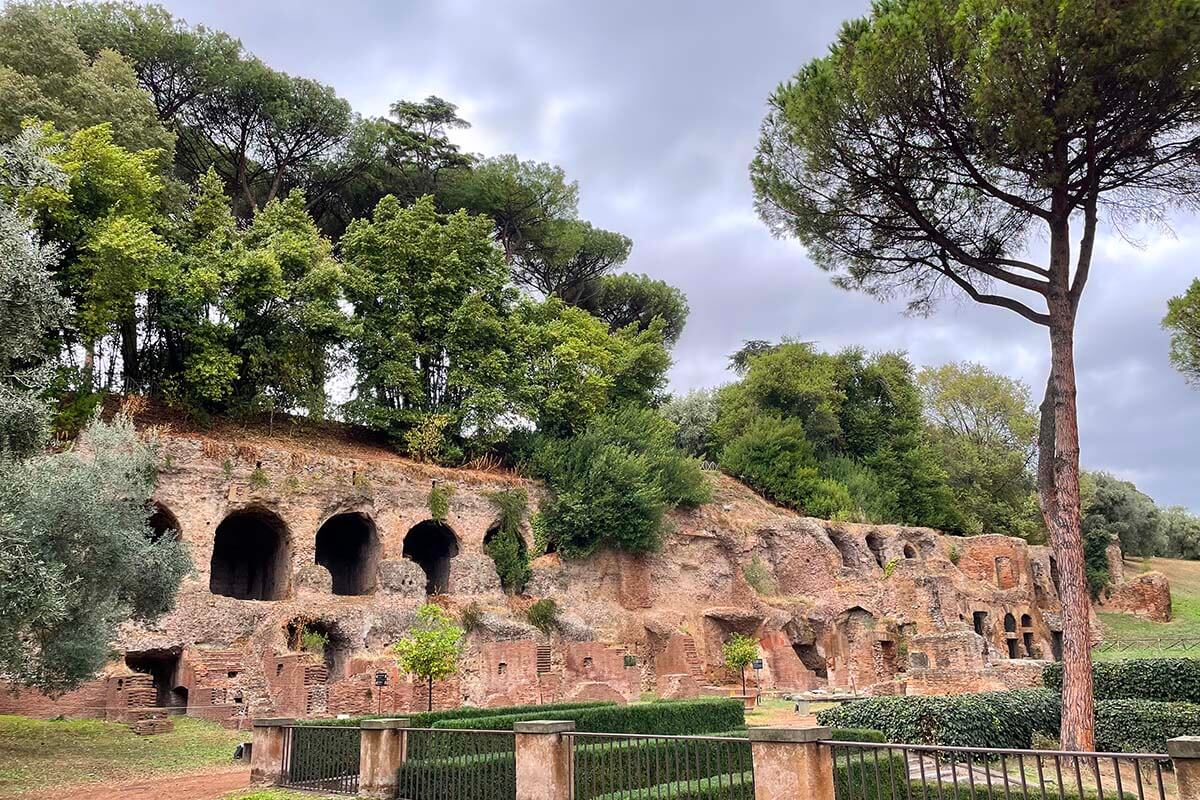
In Ancient Rome, the Palatine was one of the most desirable neighborhoods in the city. The rich and the famous built their palaces here and you can still see some very impressive ruins on the Palatine.
Right next to it is the Roman Forum, the bustling heart of ancient Rome. Today, this is a huge archeological site where you can see many of the oldest buildings and monuments of Rome.
How to visit: The Roman Forum and the Palatine are located right next to the Colosseum and an entrance to all these sites is included in the same ticket. You can just walk around on your own, but I highly recommend visiting here with a guided tour. There’s so much to see and it’s a fascinating site, but without knowing what you’re looking at, it’s just a bunch of ruins and stones…
READ ALSO: How to Visit the Colosseum (+ All Levels Explained)
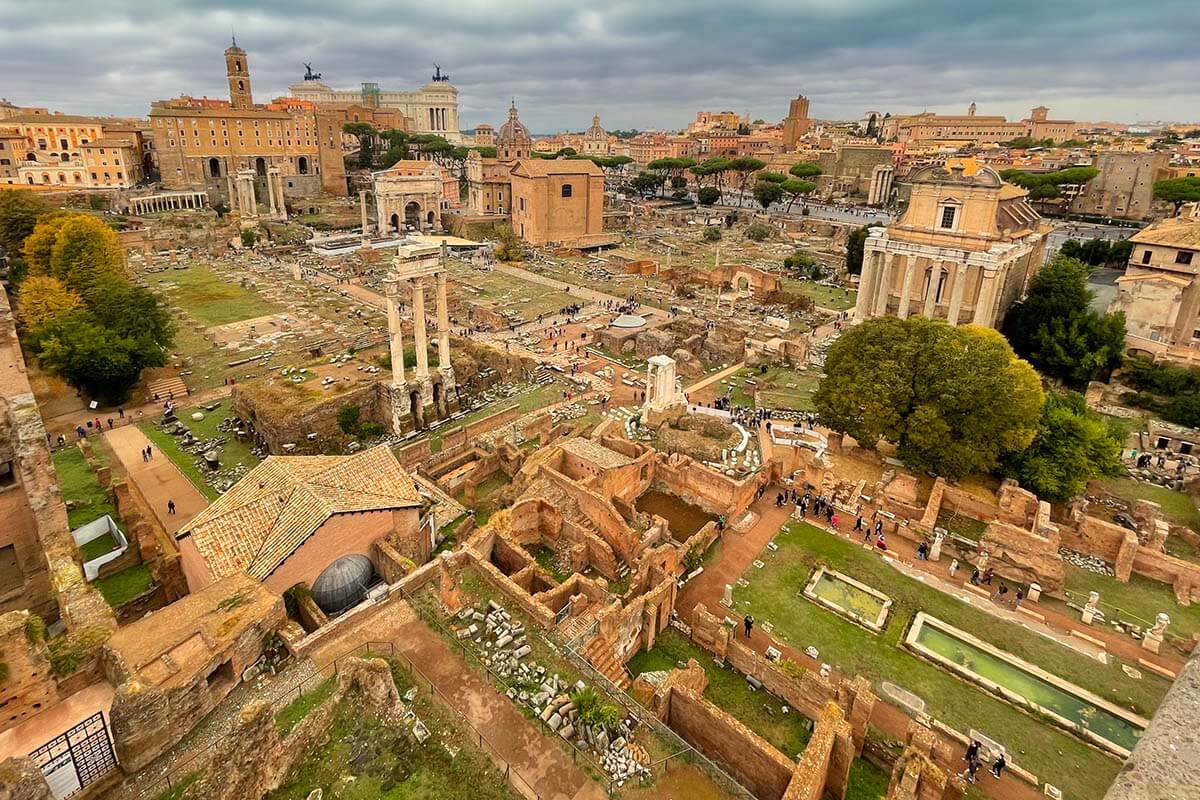
2. Ostia Antica
The origins date from the 7th century BC.
Ostia Antica was an old city, the commercial and military seaport of ancient Rome. The archeological remains found here date to the 3rd- 4th century BC, but some inscriptions are believed to be three centuries older than that.
This is one of the best-preserved ancient Roman cities and a great place to visit if you want to get a better idea of what life was like for ordinary folks in the old Roman times.
In its glory days (2-3rd century AD), over 100,000 people lived in Ostia. After the fall of the Western Roman Empire, the city slowly fell into decay. It was completely abandoned in the 9th century.
Big parts of the old city of Ostia are excavated and you can see the remains of old houses, shops, baths, but also docks and warehouses. One of the most impressive sites is the old Roman theater – Teatro di Ostia.
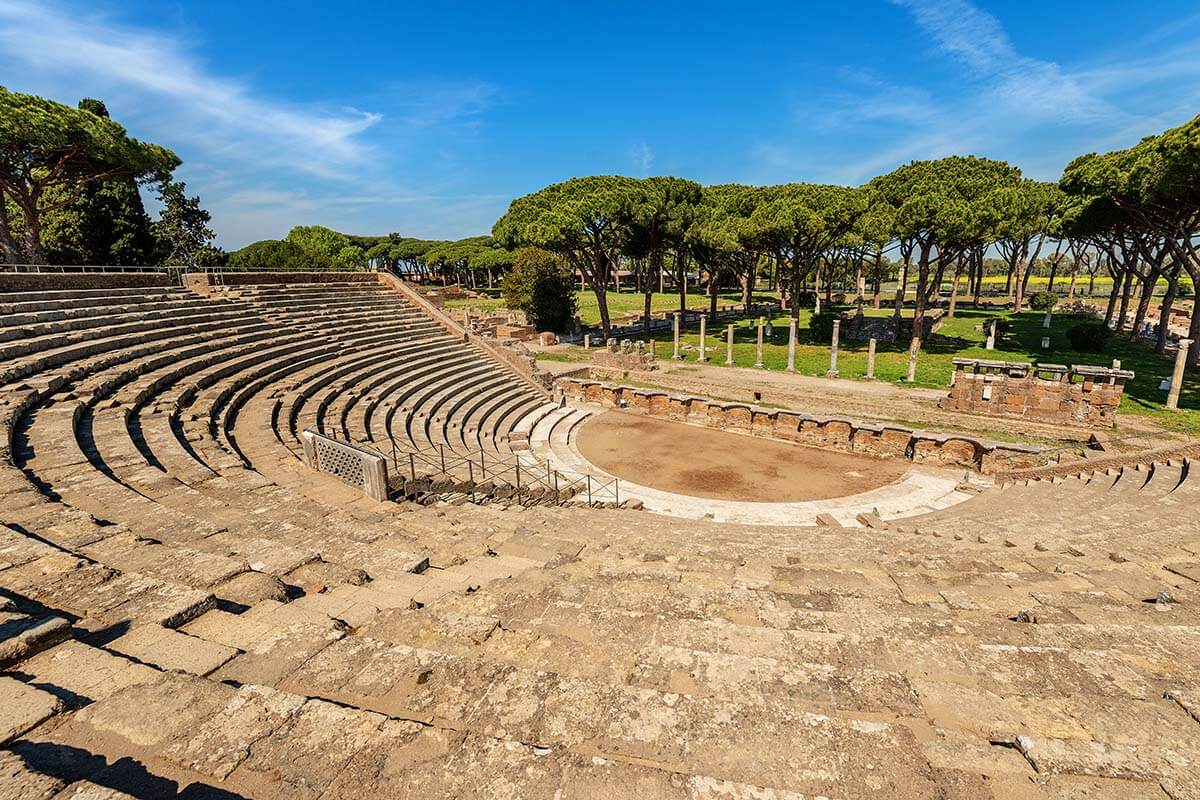
Ostia Antica is often compared to the more famous ancient Roman cities of Pompeii and Herculaneum.
However, these places are located close to Naples, a 2.5-3 hours drive from Rome (they can be visited with a tour from Rome, but you will need an entire day for that). Whereas Ostia Antica is just 45 minutes drive from the city center. In fact, it’s located very close to Leonardo da Vinci International Airport in Fiumicino.
How to visit: Ostia Antica is the only Roman landmark mentioned in this guide that is located quite a bit further from Rome’s city center. You can get here by taxi or by train, and there are also organized tours. The most popular option is this half-day guided tour by train.
READ ALSO: How to Get to Rome from the Airport
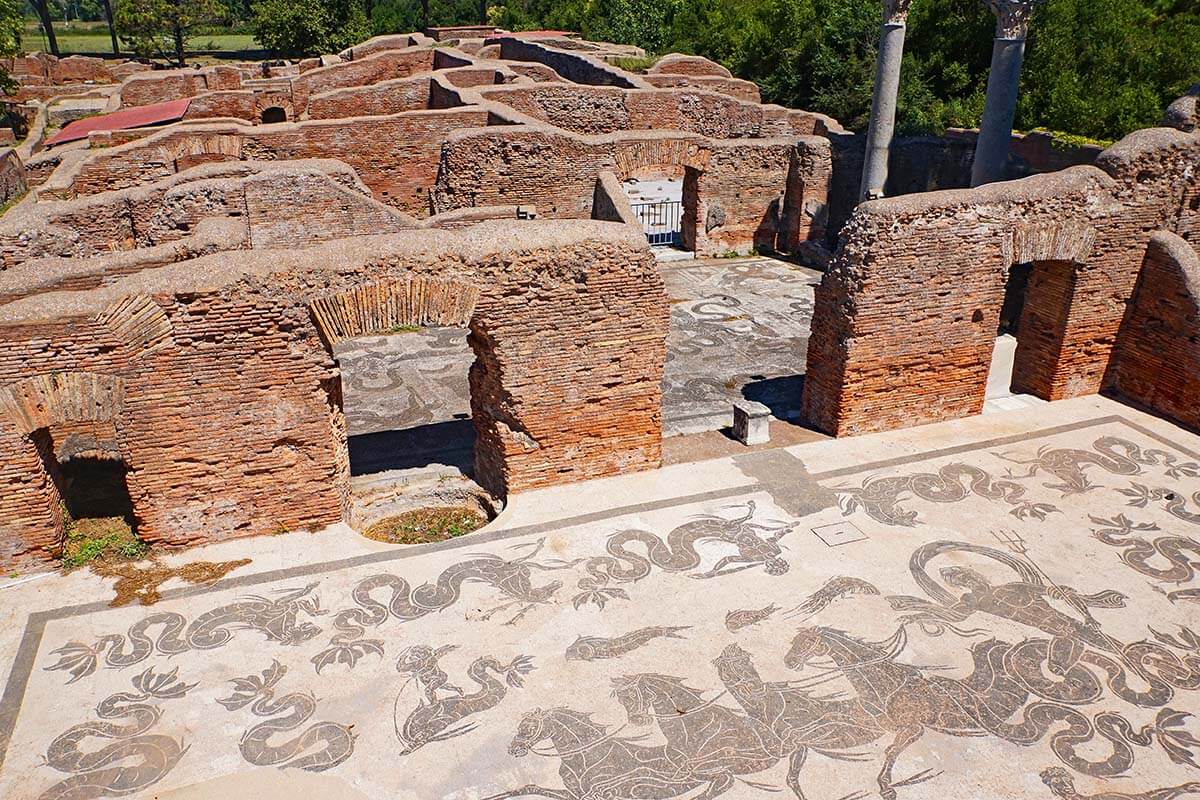
3. Circus Maximus
The origins of Circus Maximus date to Rome’s earliest days. The construction began around the 6th century BC.
Circus Maximus (Circo Massimo) was the largest stadium in Ancient Rome, mainly used for chariot races. It also served as the site of Roman Games, gladiator fights, animal hunts, etc.
Its current distinctive U-shape dates from the times of Julius Caesar who ordered the refurbishing of this arena at around 50 BC. At that time, the stadium could seat about 150,000 spectators.
After the Great Fire of Rome in 64 AD, Circus Maximus was rebuilt and reached its maximum capacity with place for about 250,000 people.
The last chariot races here were held in the 6th century, after which the ancient arena was pretty much abandoned. The area was cleared and turned into a park in the early 20th century and is nowadays sometimes used for concerts and other big outdoor gatherings. A small part of the ancient site is being excavated, but the majority remains under the ground.
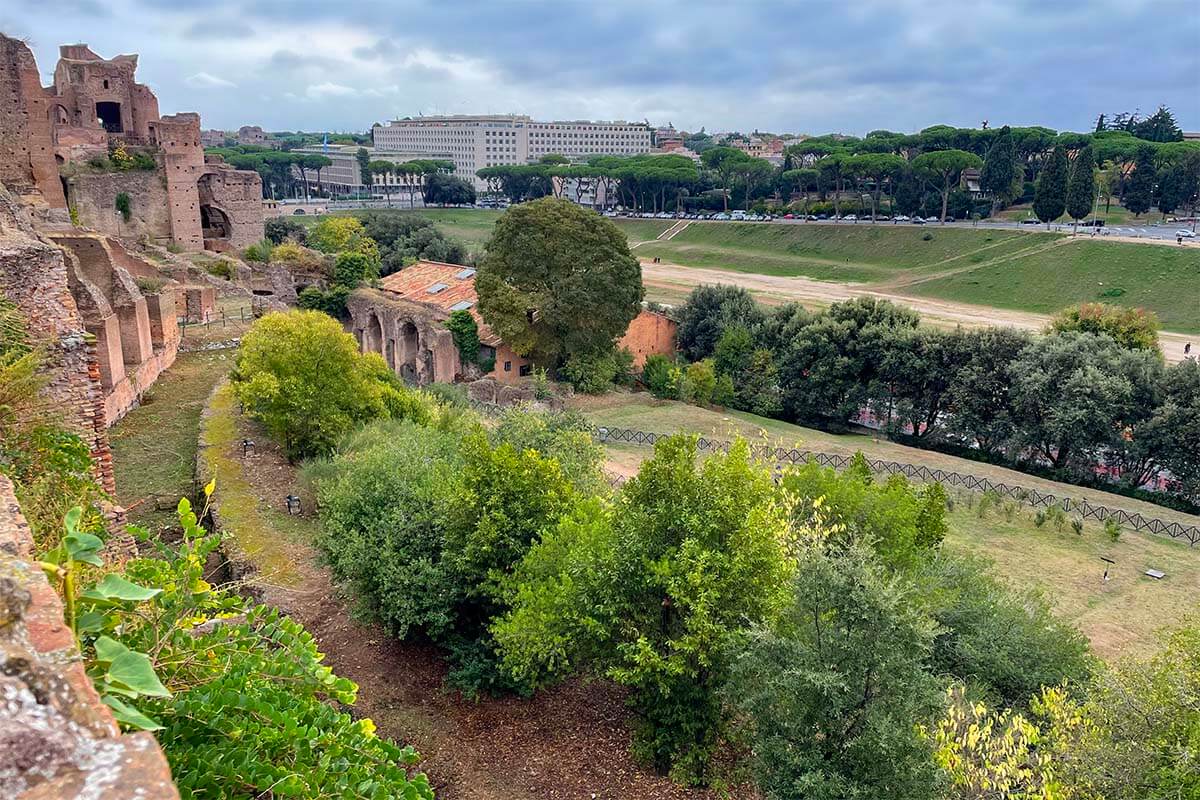
How to visit: Apart from the big open oval space in the middle of the city, there is actually not that much left of the ancient Circus Maximus nowadays. You can see it from an elevated angle from Palatine Hill, and you can also go for a walk here. Some tours also come here. It’s a good way to learn more about the place and the guides usually have pictures showing you what the place looked like, etc.
There may not be much left of it, but as you stand here, it’s easy to imagine a crowd of a quarter of a million people cheering at the chariot races: the noise, the dust, the excitement… It’s well worth seeing Circus Maximus, even if just from a distance. It’s yet another puzzle piece that gives you a better idea of what life was like in Ancient Rome.
TIP: If you are interested in a tour, we recommend this highly-rated tour that visits Circus Maximus and the Baths of Caracalla (a very interesting ancient Roman site that you can read about further below).
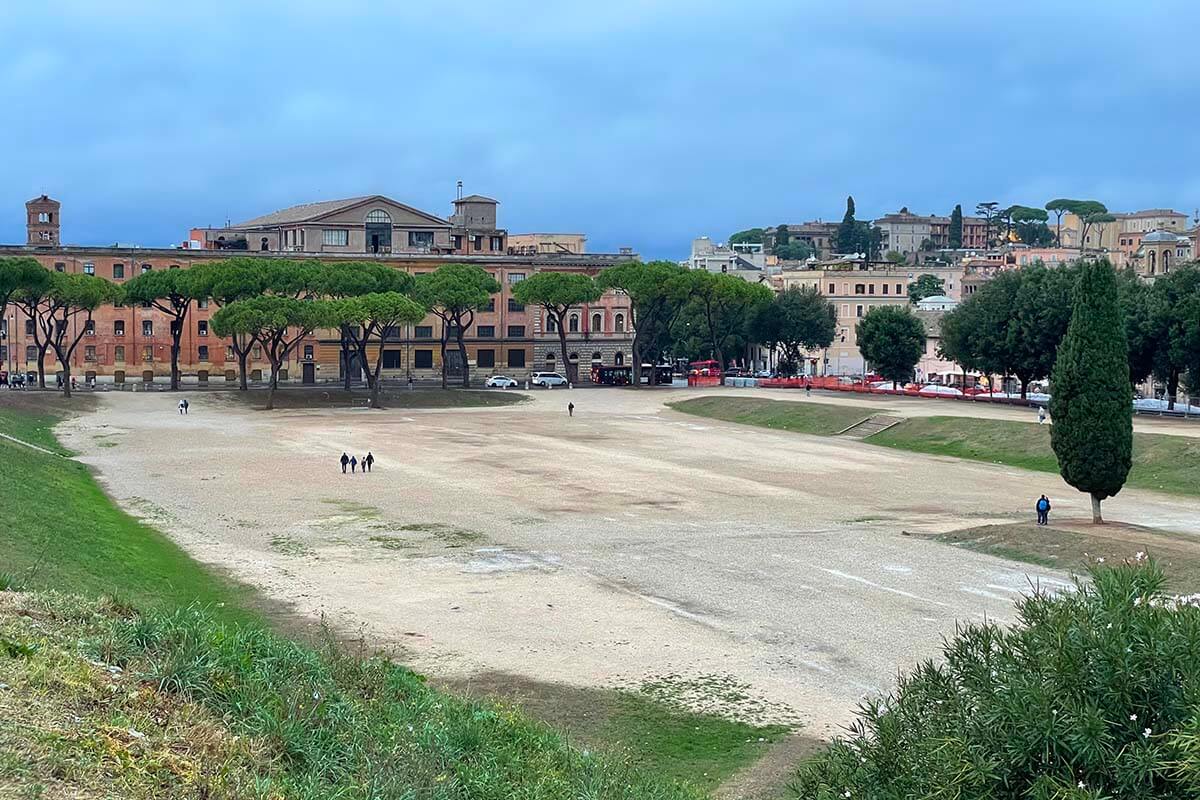
4. Appian Way
Built around 312-264 BC.
Appian Way (Via Appia Antica) is an ancient road that connected the city of Rome to Brindisi in Southern Italy, some 563 km (350 miles) away. Its main purpose was to help the army with the expansion of the Roman Empire.
To me, the Appian way feels the most authentic of all Ancient Rome sites that you can still see today. Built over 2300 years ago, some parts of this road look pretty much as they would have looked back in the old days. There are hardly any signs of modern-day life here, and if you’re lucky to visit on a quiet moment or go just a bit further from the city, you’ll likely be completely alone… It’s magical!
Appian Way is lined with ancient family graves and mausoleums, some of them still standing next to the road today (in the past, it was forbidden to bury people inside the city walls, and it was easy to have a family grave next to a major, easily-accessible way just outside the city).
As you walk or bike on Via Appia, you can easily imagine the Roman military marching here, horses and carriages driving up and down, and families visiting the graves of loved ones… If you’ve seen movies like Spartacus, vivid images of Ancient Rome come to life. It’s a really special place, and if you have a few hours extra, I highly recommend visiting here!
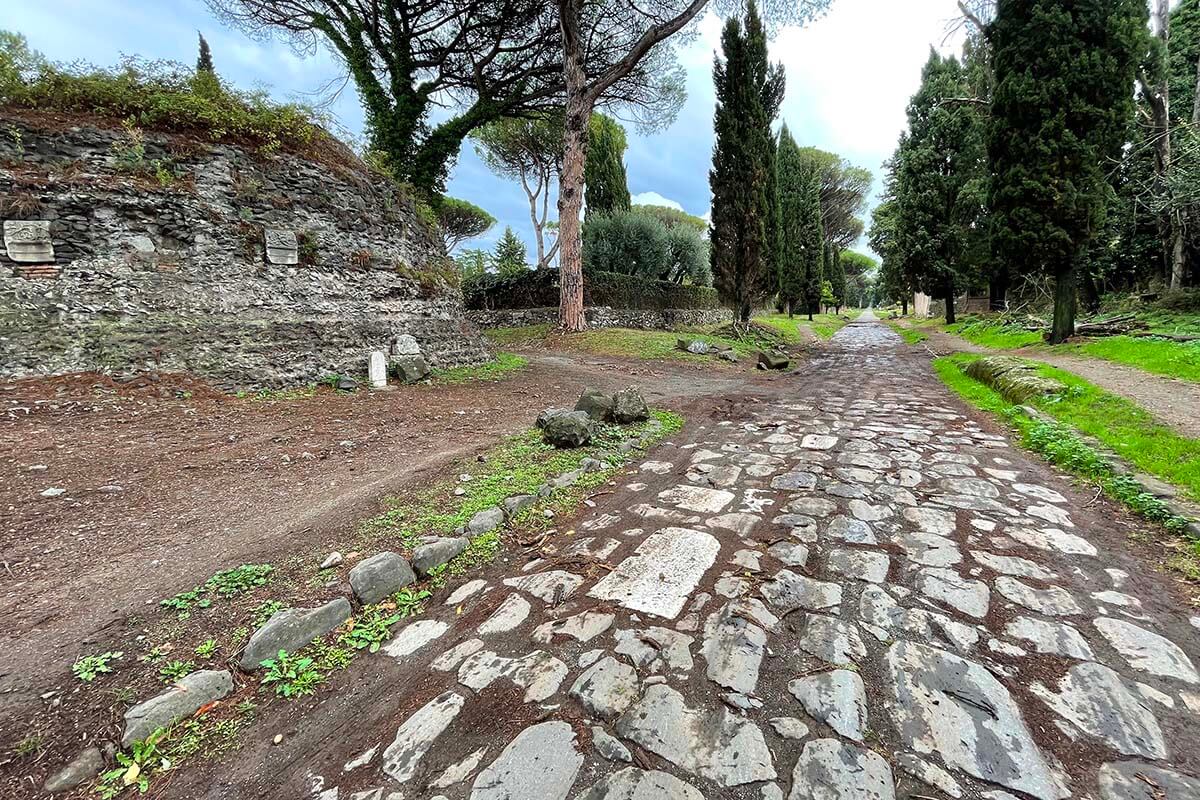
How to visit: The Appian Way is a long road that starts in Rome. The first part closest to the city has changed a lot and looks just pretty much like any other street. And while you don’t have to go very far to find some more authentic parts of this ancient way, it’s not really a place you can easily walk to. It’s best to come here by bus, on a tour, or by bike.
TIP: I highly recommend joining an e-bike tour. Not only is this the best way to get here and explore a bigger section of this unique road, but you’ll also see so much more! It’s also good to visit here with a local guide who knows exactly where to go and will bring you to the most authentic sights.
We visited the Appian Way on this great bike tour that also includes quite a few other ancient Roman landmarks mentioned further in this guide.
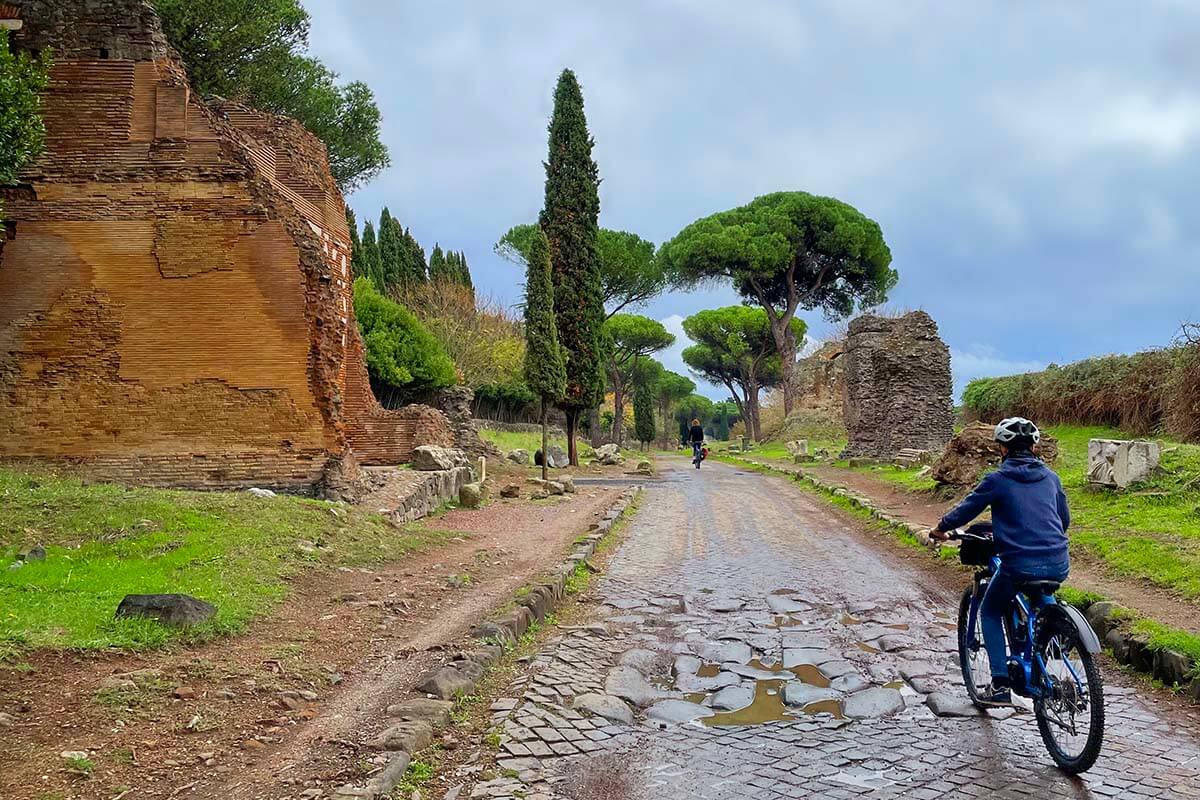
5. Park of the Aqueducts
Most Roman aqueducts date from the period between the 3rd century BC and 1st century AD. The oldest Roman aqueduct – Aqua Appia – was constructed around 312 BC, at around the same time as the Appian Way.
If you want to see more of the most authentic ancient Roman sights and get a bit more off the beaten path in Rome, definitely consider a visit to the Park of the Aqueducts (Parco degli Acquedotti). This is antique Rome at its best, and without the crowds. In fact, you’ll likely have the park all to yourselves…
Here, you can see several ancient aqueducts dating from the glory days of the Roman Empire. Reliable water supply was of utmost importance for the quickly-growing cities, and a series of aqueducts were built in order to bring drinking water from the mountains into the city of Rome.
Parts of these ancient aqueducts survived to the present day, and you can admire some really fine examples of ancient engineering. Some aqueducts were tens of kilometers in length, and they were built with such a small gradient that was just enough to get the water flowing towards the city at a steady pace. It would be quite an achievement even nowadays…
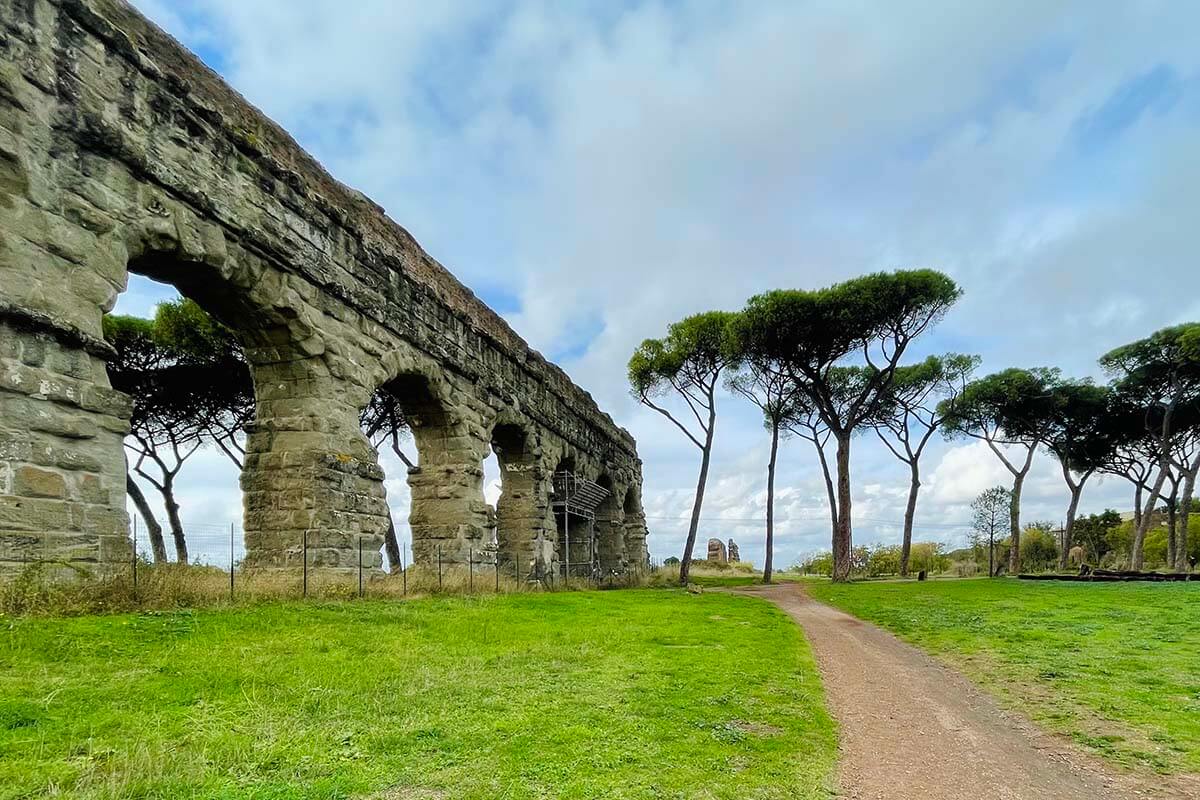
How to visit: Park of the Aqueducts is located on the outskirts of Rome, about 10 km from the city center. There’s a metro line running just nearby, so you could get here by public transport quite easily. However, it’s a massive park and so if you come on foot, you’ll need at least half a day to explore it. The best way to visit Parco degli Acquedotti is by bike.
We came here on the earlier-mentioned e-bike tour that also took us to Via Appia and the ancient catacombs (see further below). It’s really one of the best ways to explore several of the best ancient landmarks in Rome in a short time!
TIP: One of these 2000-year-old aqueducts still supplies water to the famous Trevi Fountain today. If you don’t have the time to visit the Aqueducts Park, you could also opt to visit Vicus Caprarius (aka Trevi Underground) in the city center. Here, you can see one of the ancient aqueducts under the ground.
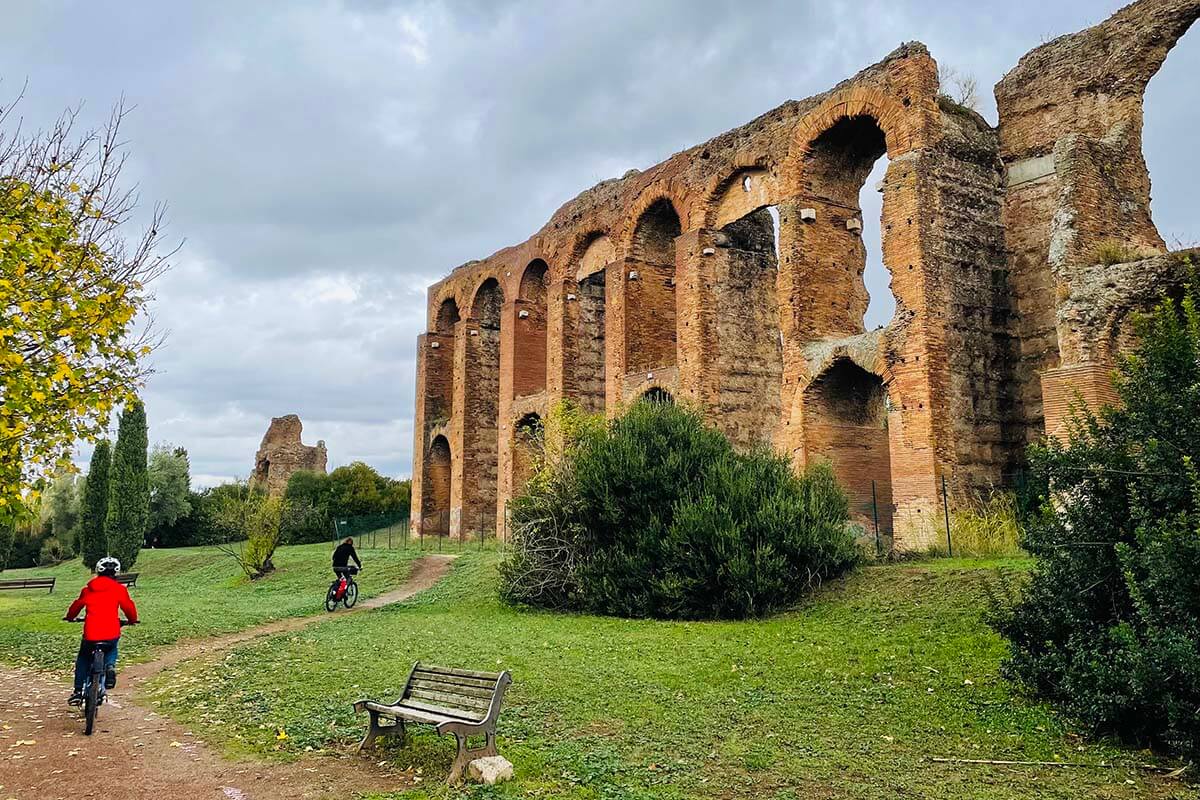
6. Largo di Torre Argentina
The ancient temples here date from the 2nd – 4th centuries BC.
Largo di Torre Argentina is a town square in the historic center of Rome. Some of the city’s most ancient temples are located here, and this was also the site of Rome’s 1st theater, the Theater of Pompey (55 BC).
The square is best known as the place where Julius Caesar was murdered by the members of the Roman Senate on the Ides of March (15 March) in 44 BC.
Most of the ancient buildings here are just ruins, but some of the remains of the temples can still be distinguished among the rest. The oldest temples are believed to date from the 4-3rd centuries BC, the others are from the 2nd century BC. They all date from pre-Christian times, but one of them was later rebuilt as a church.
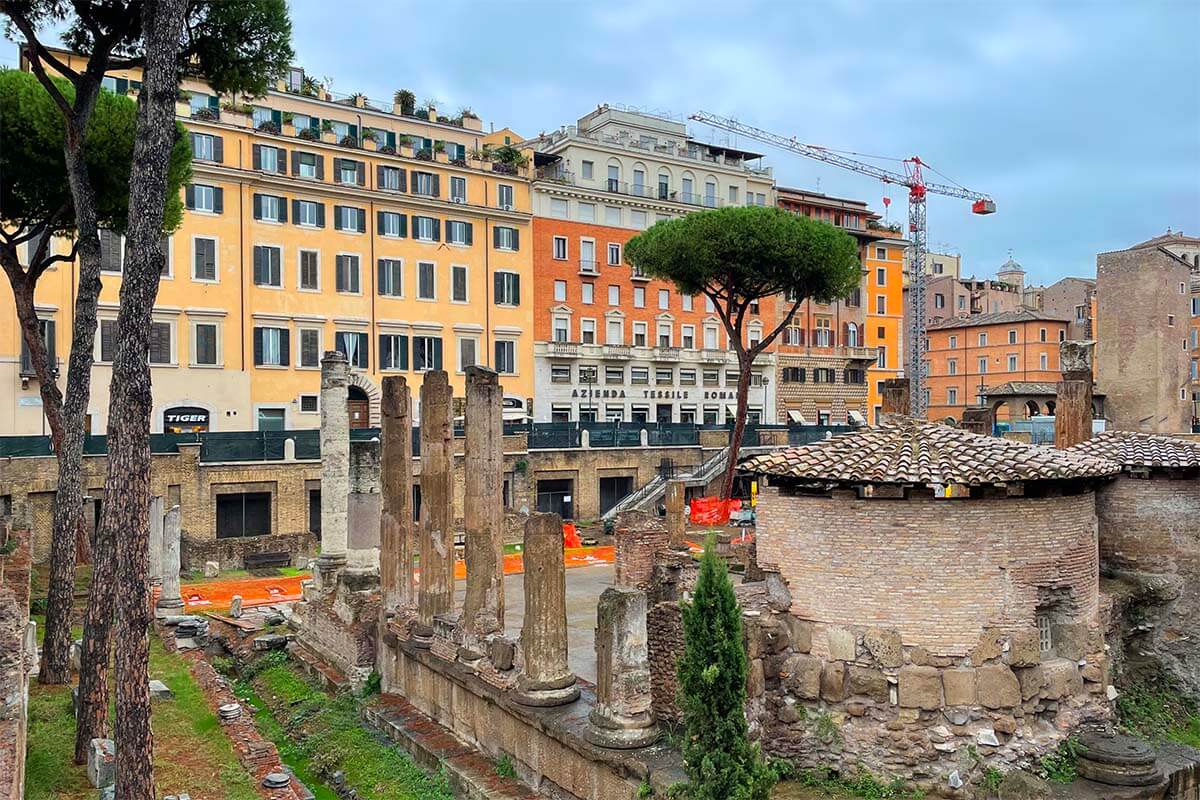
How to visit: Largo di Torre Argentina is a public square, just a few minutes walk from the Pantheon and other main sights in the city center. The archeological site has recently been made accessible to the public via a small walkway with several panels where you can learn about the history of this place. It’s free of charge and wheelchair-accessible.
You can also just walk all the way around the archeological site and easily see all the ancient buildings from the street. Some people come here to learn more about the death of Julius Caesar, others – for the ruins, and yet others for the cute cats that inhabit the area.
TIP: This amazing food tour we did in Rome also brings you to Largo di Torre Argentina and the guide gives some explanation about the sites you see.
LEARN MORE: Rome Street Food Tour with a Local Guide
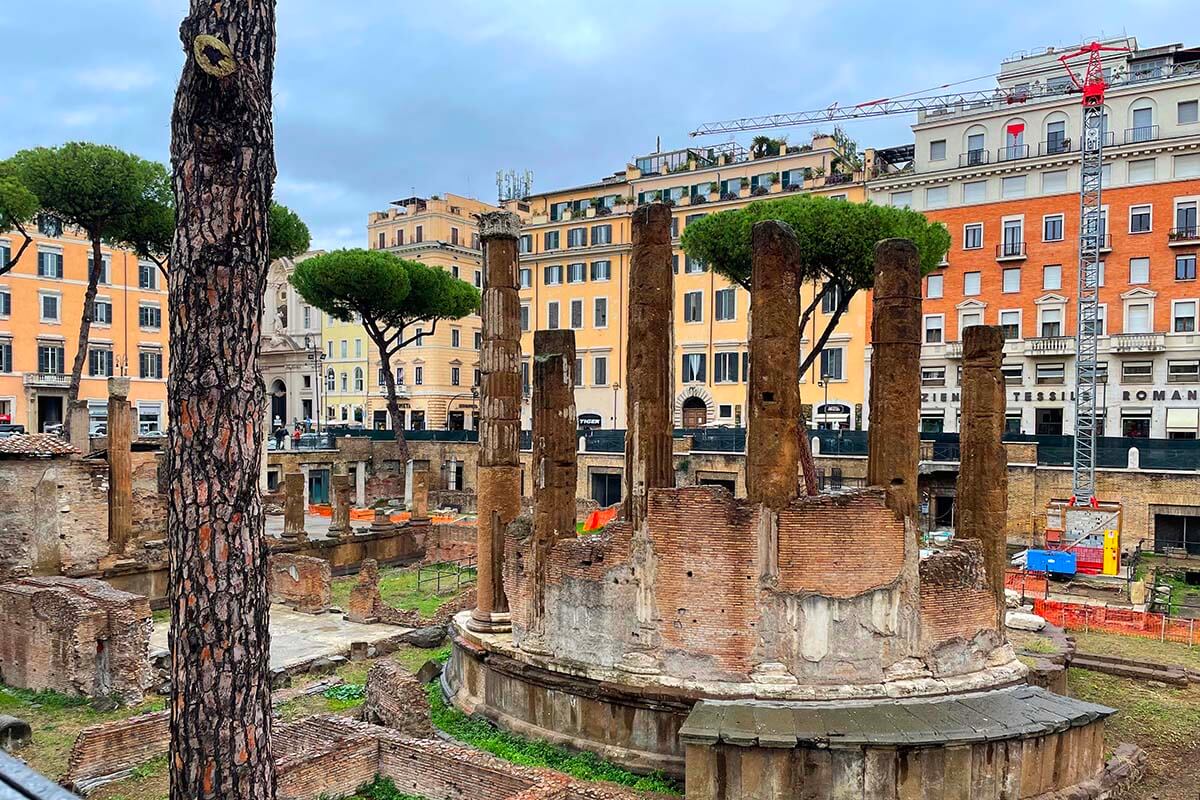
7. Pyramid of Caius Cestius
Built in 18-12 BC.
Looking somewhat out-of-place and totally different from anything else in Rome, the Pyramid of Cestius (Piramide di Caio Cestio) is one of the oldest and best-preserved landmarks in the city.
Just as the famous pyramids in Egypt, this one was also built as a mausoleum. Inside, is the tomb of Gaius Cestius, a wealthy Roman magistrate who died in 12 BC.
The pyramid of Cestius survived for over 20 centuries mainly because it was integrated into the city walls. You can still see one of the old city gates – Porta San Paolo (3rd century) – just next to the pyramid.

How to visit: You can see the pyramid from the outside at any time.
However, it is only open to the public a few days a month and if you want to visit inside, you’ll have to book it in advance. For more information, please consult the official website.
The chances that they are open just when you’re in Rome aren’t very high and it does require quite some planning, so this is one of those landmarks that you can best admire from the outside.

8. Theater of Marcellus
Built around 17-13 BC.
Marcello Theater (Teatro di Marcello) was the largest and most important theater in Ancient Rome, with space for almost 20,000 spectators. Its original construction looks a bit like the famous Colosseum, which was built almost 100 years later.
Built in the 1st century BC, this open-air theater remained in use until the early 4th century. Just like many old buildings in Rome, it was then looted and the stones were used for the construction of other buildings. What remained of it, was later used as a sort of an apartment building, and afterwards as a fortress.
Nowadays, the archeological site is a museum and it’s sometimes used for concerts as well. The upper part of the building still serves as residential apartments. Marcello Theater looks really impressive at night when it’s nicely lit.
In addition to the ancient theater, you can see lots of other ruins here as well that are yet several centuries older. The most notable is Portico of Octavia (2nd century BC) and also the Temples of Apollo Sosiano and Bellona (5th-1st centuries BC), plus Tempio di Giano (3rd century BC).

How to visit: You can see the theater of Marcellus from the street (the best view is from Via del Teatro di Marcello), but the archeological site can also be visited inside. It is normally open from morning to dusk and is free to visit.
There are informational panels and you can just walk through here when visiting the Jewish Ghetto or on your way from/to Circus Maximus or Bocca della Verità (Mouth of Truth).
TIP: Outside this archeological site, but also just near the theater, you’ll find several other lesser-known ancient Roman landmarks. This is the site of the cattle market Foro Boario (3rd century BC). Here, you can see the remains of two temples – Tempio di Portuno (2-3rd century BC) and Tempio di Ercole Vincitore (2nd century BC). If you’re in the area anyway, it’s worth checking them out as well.
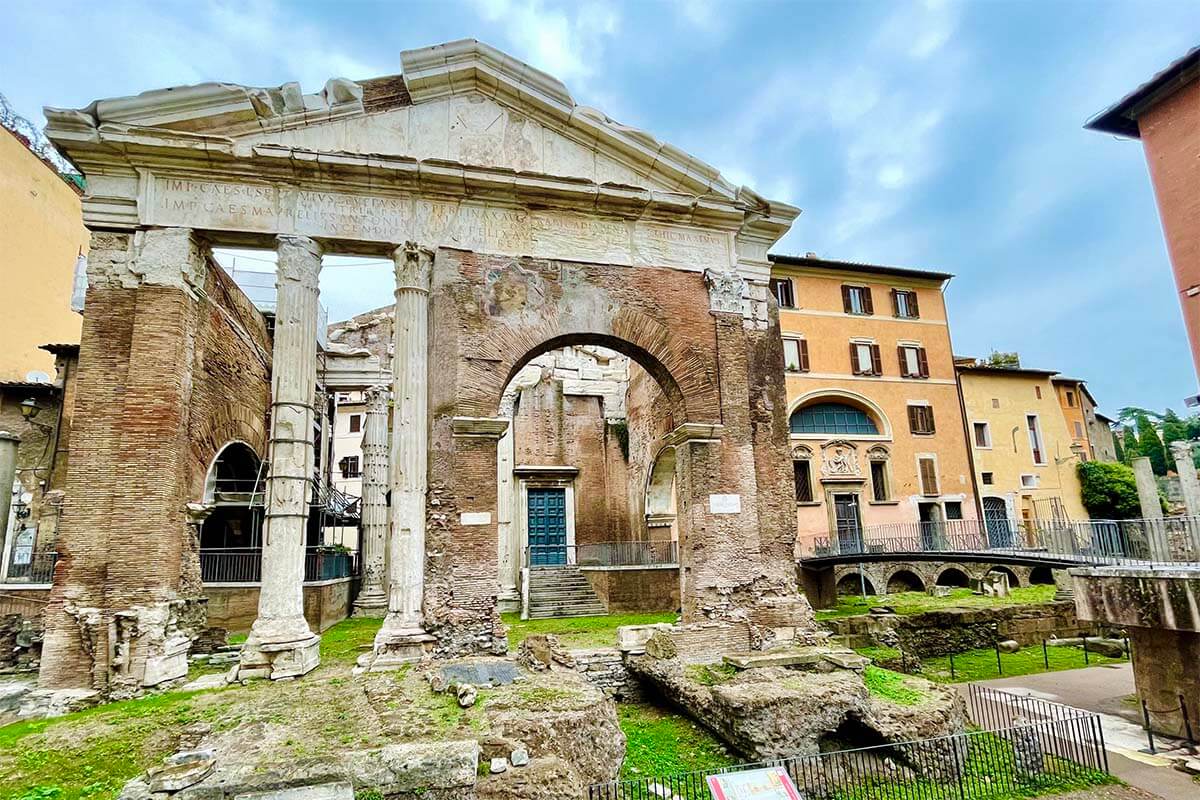
9. Domus Aurea
Built around 65-68 AD.
Domus Aurea, aka the Golden House of Nero, is another ancient landmark worth seeing in Rome. It’s located just a stone’s throw from the Colosseum that was built just a bit later.
After the Great Fire of Rome in 64 AD, Emperor Nero seized a huge centrally-located plot of land in order to build a lavish entertainment complex for himself and his guests. This started the rumors that he might have started the fire in the first place…
Domus Aurea was a lavish entertainment site with landscaped gardens, an artificial lake, fountains, pools, etc. The huge villa was richly decorated and had a rotating dining room with a golden dome with an oculus, a masterpiece of ancient engineering. The building materials included marble, gold, and mosaics made of precious stones and ivory, etc.
The Golden House represented the best of the Roman Empire’s art and engineering, but also the worst of its excesses. The project was hugely unpopular and after Nero’s death, a big part of the site was covered by ground. In fact, the Colosseum was built over the site of Nero’s artificial lake. The villa itself was still used by other emperors, but a few decades later new bathhouses were built over it…
Covered by the earth, Domus Aurea remained very well preserved. It was rediscovered in the 15th century and became an inspiration to many Renaissance artists. However, the exposure to the elements has done a lot of damage, and because a large part of the site remains under what’s currently a park, it’s extremely difficult to preserve what’s left of it without causing a complete collapse.

How to visit: Domus Aurea is located at Colle Oppio Park; the entrance is on Via della Domus Aurea. You can visit a small part of the original site, partially underground.
The Golden Vault Room virtual reality experience gives a good idea of what this place must have looked like in the past. Here you can see the availability and book a guided tour.
TIP: If you have more time, we highly recommend opting for a guided tour that also includes the Virtual Reality experience!
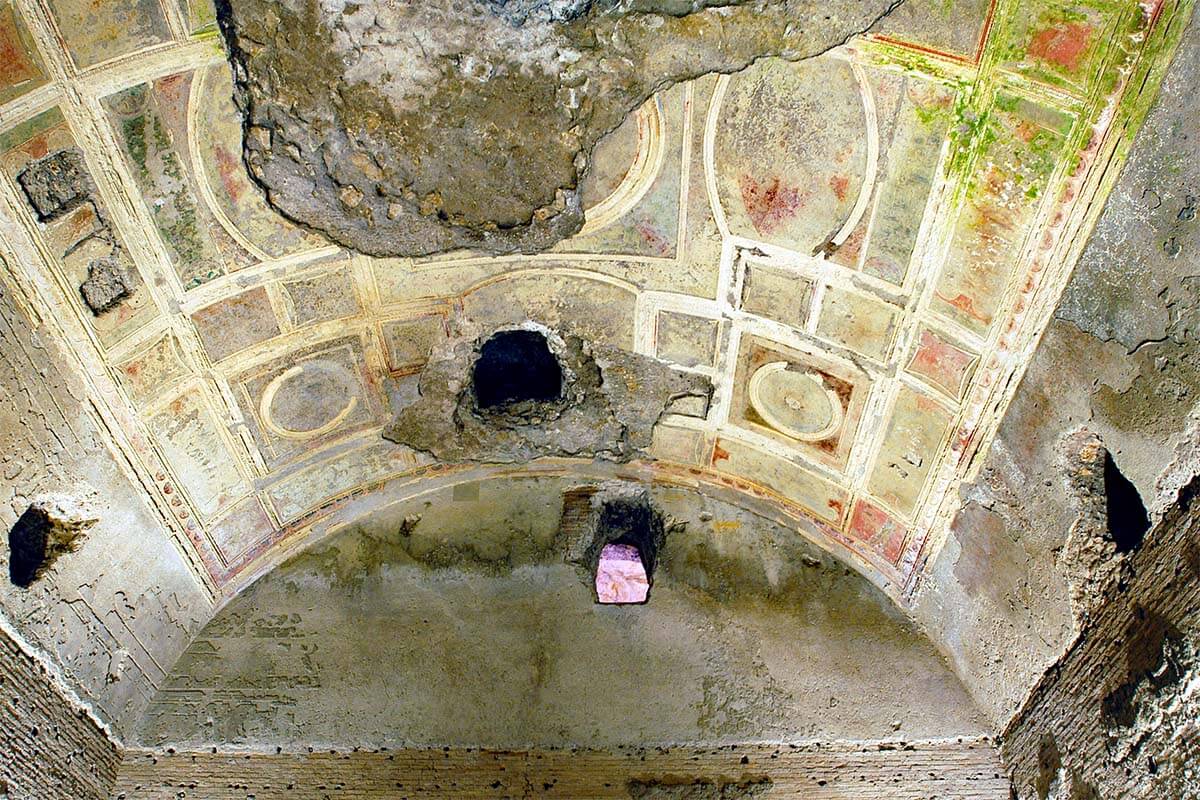
10. Colosseum
Built around 70-80 AD.
The Colosseum (Colosseo) is probably the most iconic and best-known of all Ancient Rome landmarks. Almost 2,000 years after it was built, it remains the symbol of the Roman Empire, but also of Rome as we know it today.
This was the largest and the most impressive ancient amphitheater. Despite being ruined by several earthquakes, plundering, and looting, the Colosseum still stands today. Built as an entertainment arena, it could seat some 50,000 – 80,000 spectators!
The main purpose of the Colosseum was to keep the regular people of Rome content by providing entertainment (remember the old Latin saying “panem et circenses” – bread and circuses). The amphitheater was used for public spectacles including gladiator fights, animal hunts, but also the recreation of sea battles and dramas based on ancient mythology.
A big part of this impressive building is quite well preserved and you can get a pretty good idea of what the original arena would have looked like. It’s really interesting to see all the different layers of the structure. So if you can, take the time to walk around it and explore deeper, – you’ll appreciate it so much more.

In addition to seeing the Colosseum from the outside, you really have to see the inside as well. Part of the arena floor has been restored and you can also take in the views from the upper levels.
It’s now also possible to visit the underground level which gives you a very unique insight into how the arena functioned. You can see where the wild animals were kept, where the gladiators waited for the fights, the mechanisms used to bring them upstairs, etc.
How to visit: You can see the Colosseum from the outside and walk around it. But you’ll need a ticket to visit inside. This is one of the two most popular Rome attractions in Rome (together with the Vatican) and you really have to book your tickets in advance.
TIP: If you want to visit the Underground of the Colosseum, you’ll need to go with a guide. We chose and recommend a small-group tour that includes the Underground, the Arena Floor, and the earlier-mentioned Roman Forum and Palatine Hill.
LEARN MORE: Colosseum Levels & Best Ticket Options
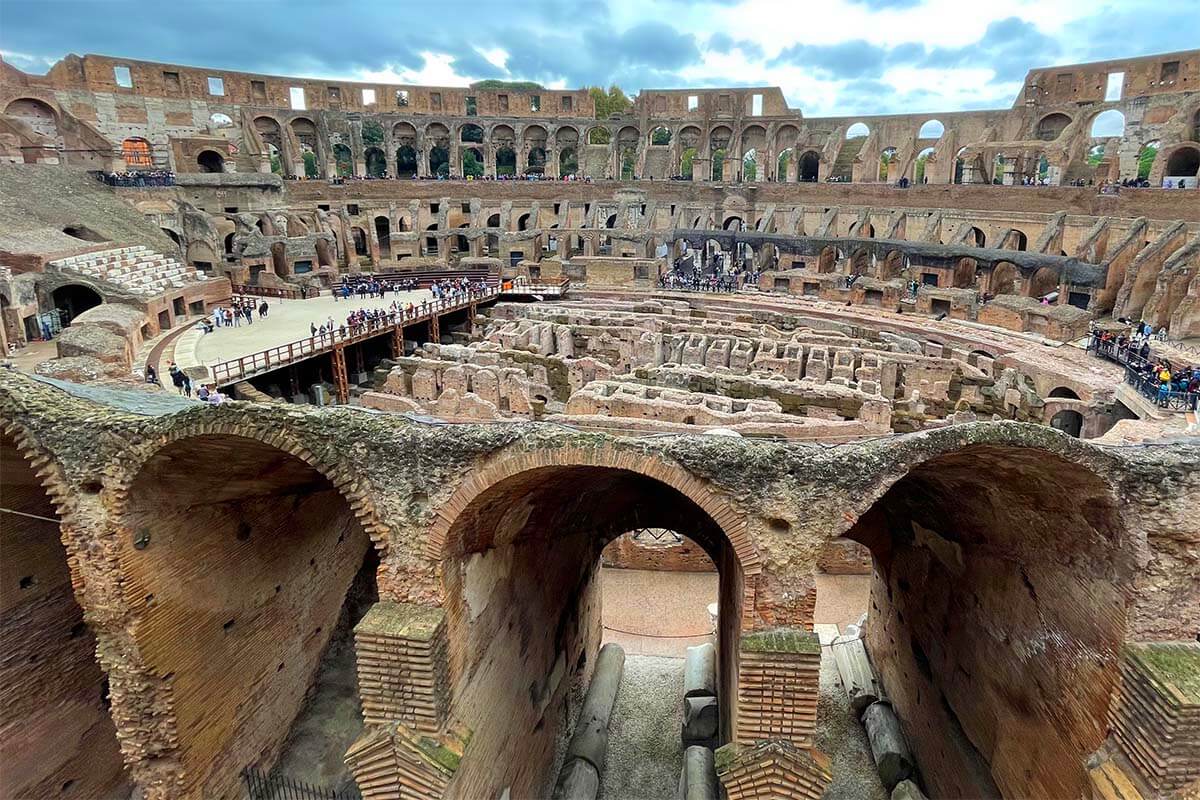
11. Trajan’s Market
Built around 100-110 AD.
Trajan’s Market (Mercati di Traiano) is a 2nd-century Roman market, often described as the oldest shopping mall in the world. It was part of a bigger complex – Trajan’s Forum – that was once the bustling center of the Roman Empire.
This architectural site is not only a fine example of ancient Roman architecture, but it also gives you a unique insight into the everyday life of the Roman people. It’s also a good place to see how the city has changed over the centuries.
The markets were mainly used in the 2-5th centuries. Later, new floor levels were added, a tower was built, and in the 16th century, there was a convent here… At the beginning of the 20th century, some of the recent additions have been demolished again, and an effort was made to restore Trajan’s Market and the surrounding area.
In 2007, the Museum of Imperial Fora was opened here, and you can now explore this unique site from close by. Walking on the original streets of ancient Rome – Via Biberatica and Via della Torre – is a really special experience. This is one of the places where you can truly feel the antique Rome around you. And despite its very central location, only very few tourists seem to find their way inside…
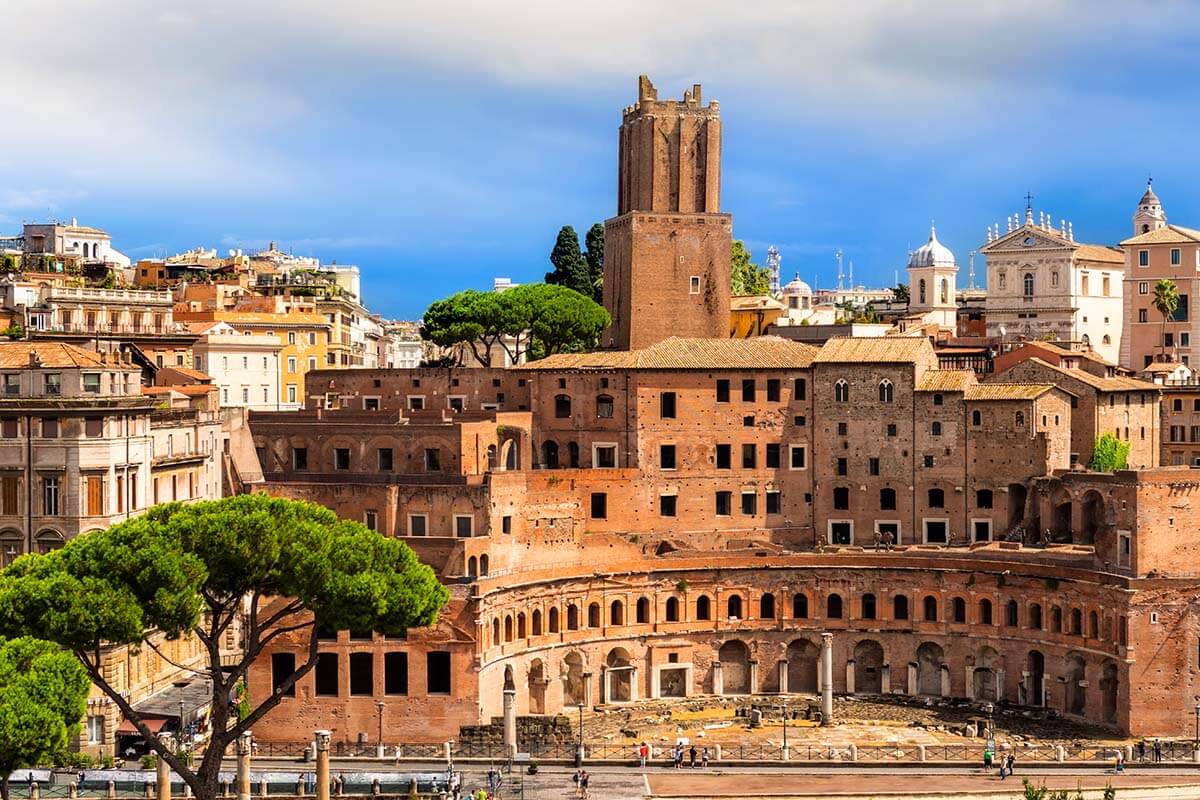
How to visit: You can see a big part of the Trajan’s Market archeological site from Via dei Fori Imperiali, the main street between Piazza Venezia and the Colosseum. However, if you want to learn more about it, walk on the ancient streets, and explore the most impressive parts, be sure to visit the Museum of the Imperial Fora in the Trajan’s Markets.
It’s open daily except for some public holidays. More info on the official website. The entrance here is included with several city passes.
TIP: If you have more time to explore here, get a ticket that includes a multimedia video. This video gives you a unique insight into what Trajan’s Markets looked like during the glory days of Imperial Rome.
In addition, as you walk on Via dei Fori Imperiali towards the Colosseum, you can see the ruins of the Forum of Augustus (2 BC) and too many other ancient ruins to even try to mention.
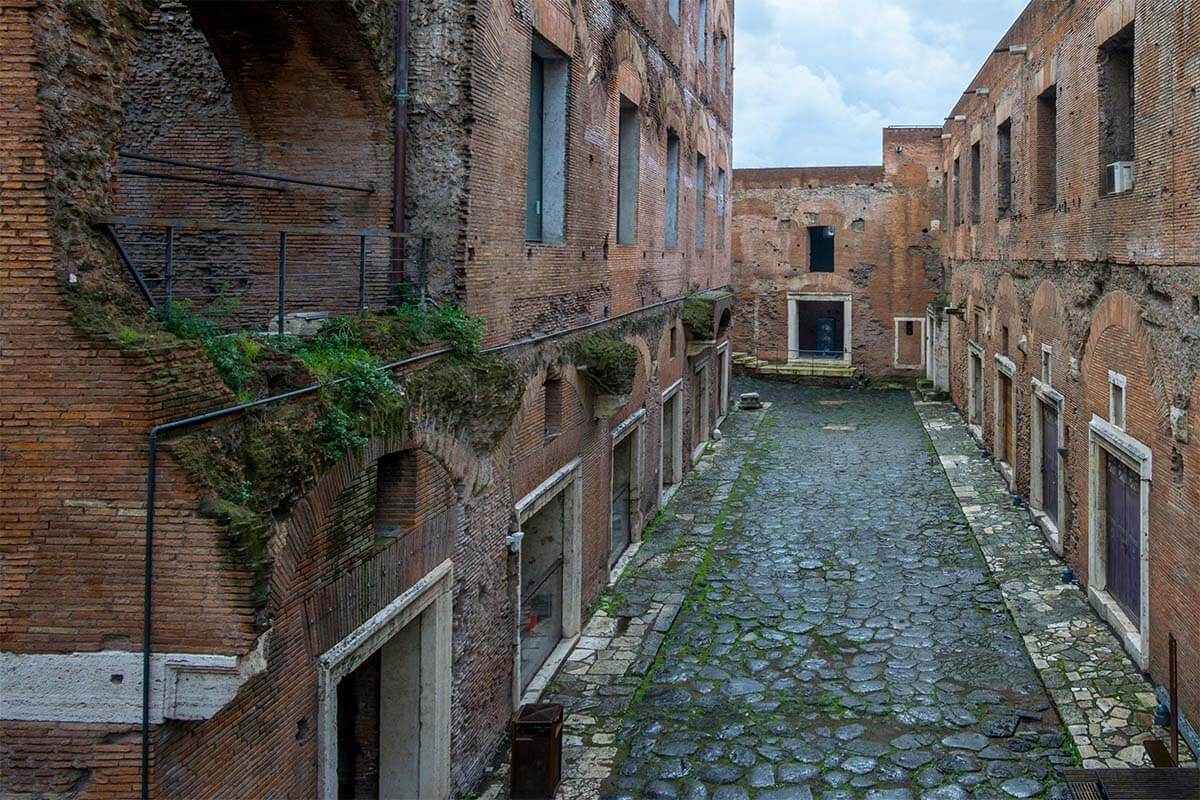
12. Pantheon
The origins go back to 27 BC, but the Pantheon as we know it today was built around 125-127 AD.
Built almost 2,000 years ago and still standing strong, the Pantheon is the best-preserved of all ancient monuments in Rome. In fact, the Pantheon is the oldest building in the world that is still in use today.
Dating from before Christianity, the Pantheon was originally built as a temple to all gods. However, it was later converted into a church (7th century). This saved the old temple from looters and plundering and helped preserve this unique monument through so many centuries.
The Pantheon has also served as the burial place for many artists and kings. Inside, you can see the tombs of Raphael, King Victor Emanuele II, King Umberto I, Queen Margherita of Savoy (after whom pizza Margherita was named), and several others.
World-known for its impressive oculus, the Pantheon has inspired many generations of architects and engineers, including Michelangelo who designed the dome of St. Peter’s Basilica in the Vatican. Michelangelo was so impressed by the unknown ancient architect and its genius dome structure that – out of respect – he made sure that his own construction was slightly smaller.
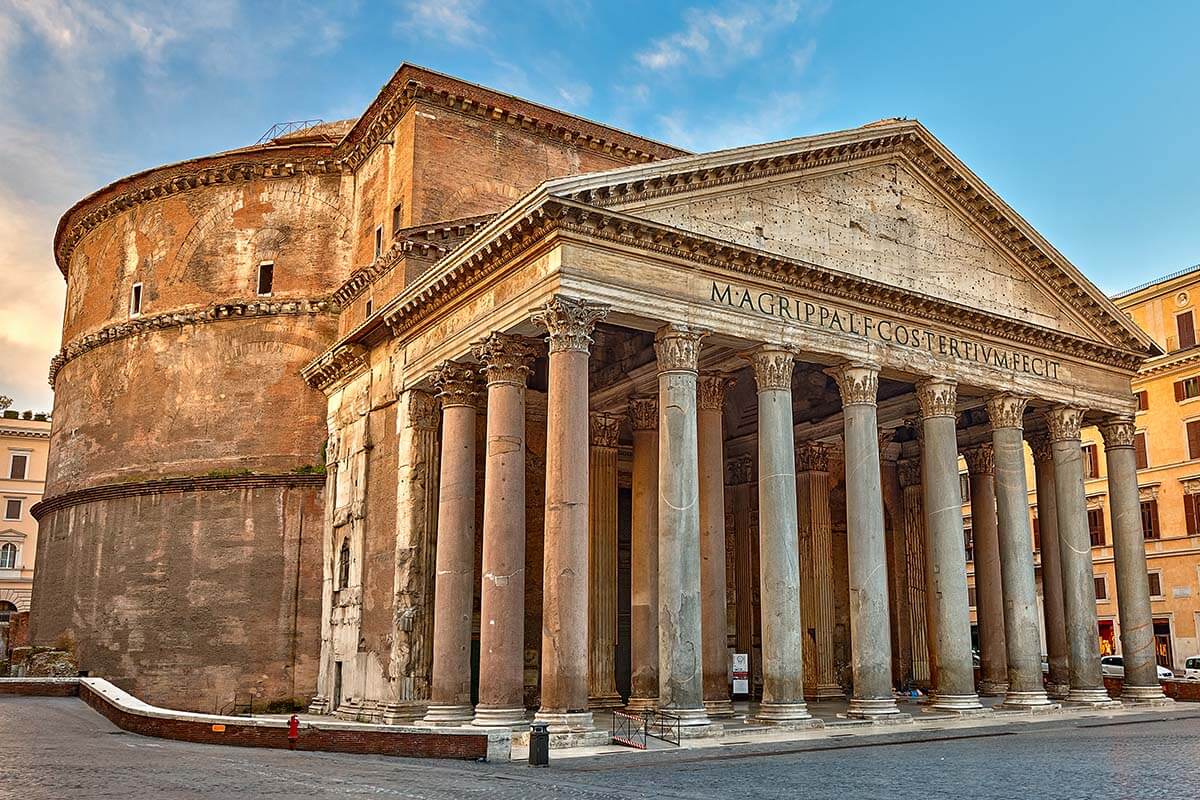
How to visit: The Pantheon is a working church, but it can only be visited for free during mass (and you won’t be able to walk around).
It’s open daily, and if you want to visit it as a tourist, you need to pay for a ticket. While you can ‘just’ queue at the entrance, we recommend getting a timed entry ticket in advance. The queues can be really long, there are multiple lines, and it’s overall quite chaotic. Even with online reservations, you have to pick up an actual ticket at another location first (hopefully, they’ll change this in the future, but be sure to read the instructions!).
You can book the Pantheon tickets on the official website (which many of our readers find confusing), or on GetYourGuide, which is super easy to use and should really be your one-stop shop for all Rome tickets! All online tickets include an audio guide.
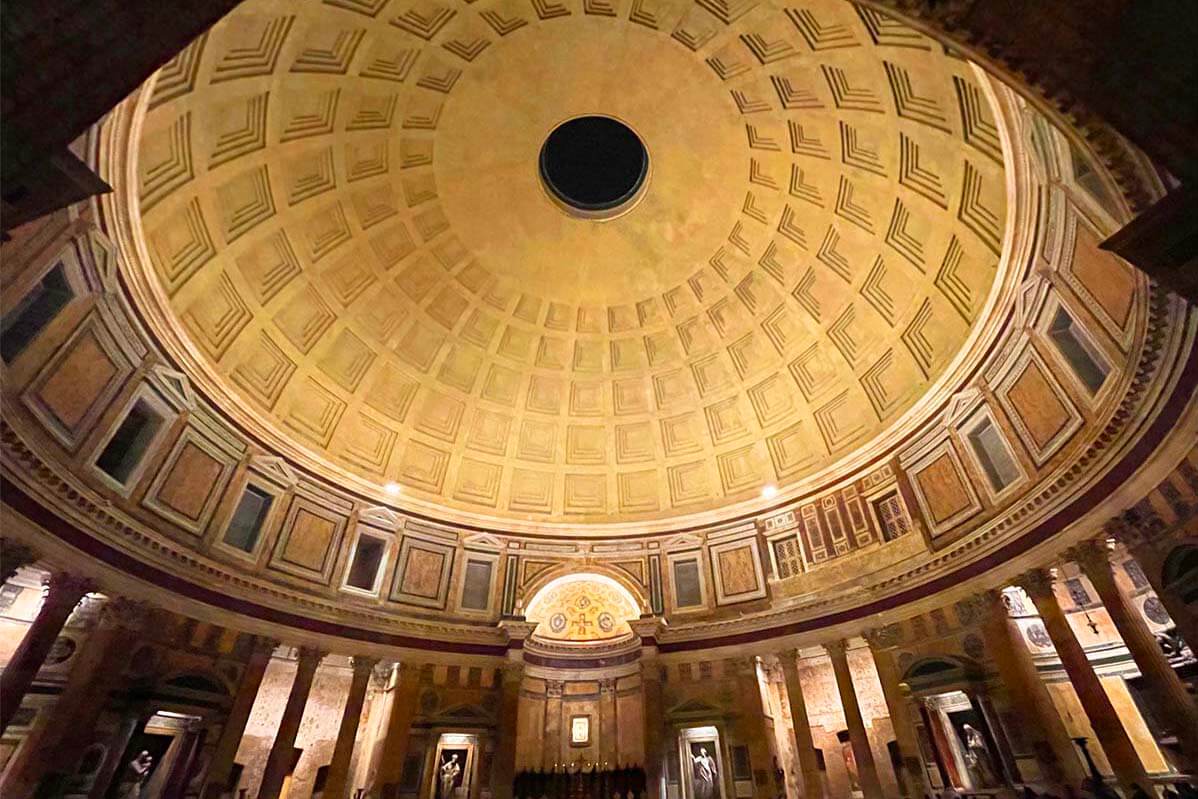
13. Castel Sant’Angelo
Built around 134-139 AD.
Castel Sant’Angelo (Mausoleum of Hadrian) is another ancient Roman landmark that you really can’t miss in Rome.
Once the tallest building in Rome, it might look a bit like a castle indeed, but it’s actually a tomb. This impressive mausoleum was built in the 2nd century for Emperor Hadrian and his family. The ashes of several other emperors were placed here as well, including Emperor Caracalla at the beginning of the 3rd century.
At the beginning of the 5th century, the mausoleum was looted and turned into a military fortress. In the 14th century, the building was turned into a castle and was subsequently used by various popes. A covered fortified corridor was built in order to connect Castel Sant’Angelo to the old St. Peter’s Basilica at the Vatican.
Nowadays, Castel Sant’Angelo serves as a museum. Inside, you can see some perfectly preserved frescoes from the Renaissance, visit the Chamber of Ashes where the emperors were incarcerated, and see the Papal Residence.
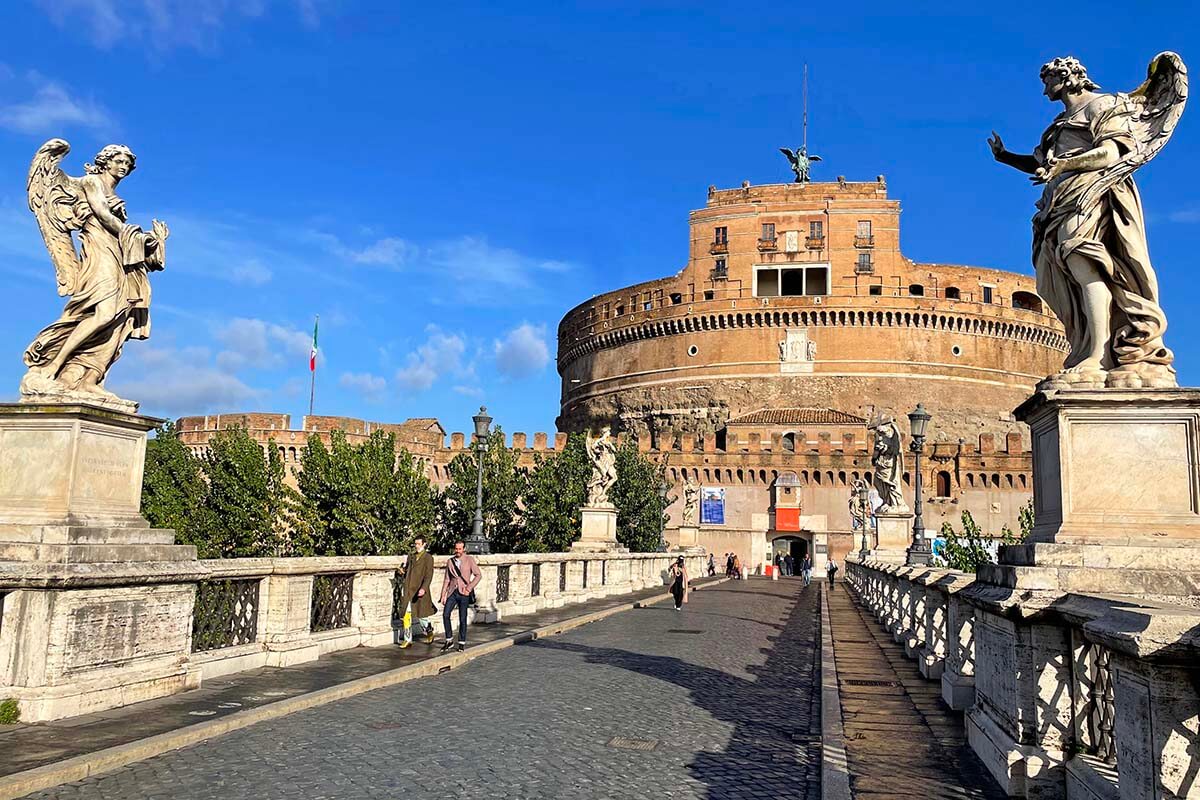
How to visit: You can just see the building from the outside, but you can also visit the inside. It’s located on the main route on your way to the Vatican.
You can get a fast-track ticket and visit on your own or join a guided tour. The entrance to the museum is also included with the Omnia Pass.
TIP: Don’t miss the panoramic views from the rooftop terrace of the museum. It offers amazing views of the River Tiber, the historic city center, and the Vatican.
READ ALSO: Best Viewpoints in Rome
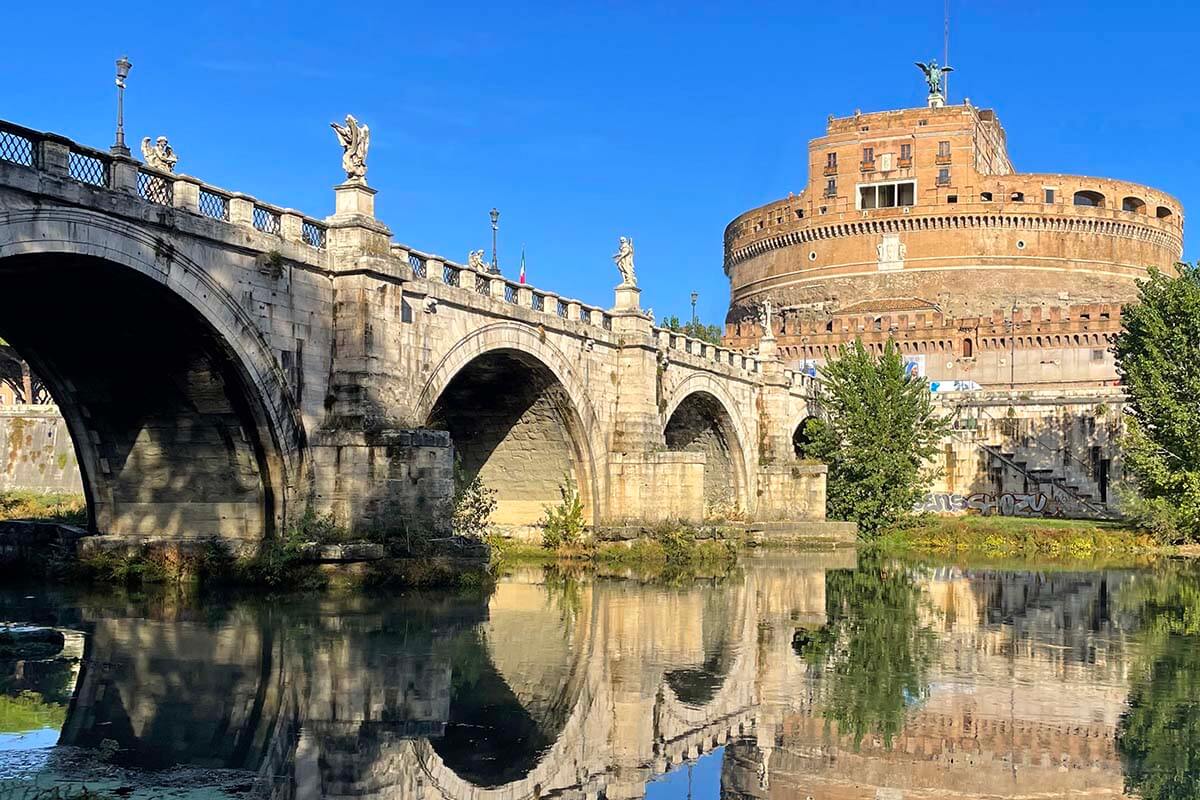
14. Catacombs of St. Callixtus
Built between the 2nd and the 5th century AD.
If you are looking for even-more unique sites to see in Rome, consider visiting some of the ancient catacombs (underground burial sites). There are over 60 known catacombs in Rome, with hundreds of kilometers of subterranean tunnels, and hundreds of thousands of graves. Some of these catacombs are open to the public.
Probably the most special and best-known are the Catacombs of St. Callixtus (Catacombe di San Callisto), located next to the Appian Way mentioned earlier. This ancient site stretches for about 20 km (12 miles), is over 20 meters (65 ft) deep, and contains about half a million graves.
Several Popes were buried at this site and you can visit the crypt of the Popes. In addition, you can see the crypts of some early Christian martyrs, including the crypt of St. Cecilia. You can also walk around and explore underground galleries and see hundreds of – now empty – tombs around you.
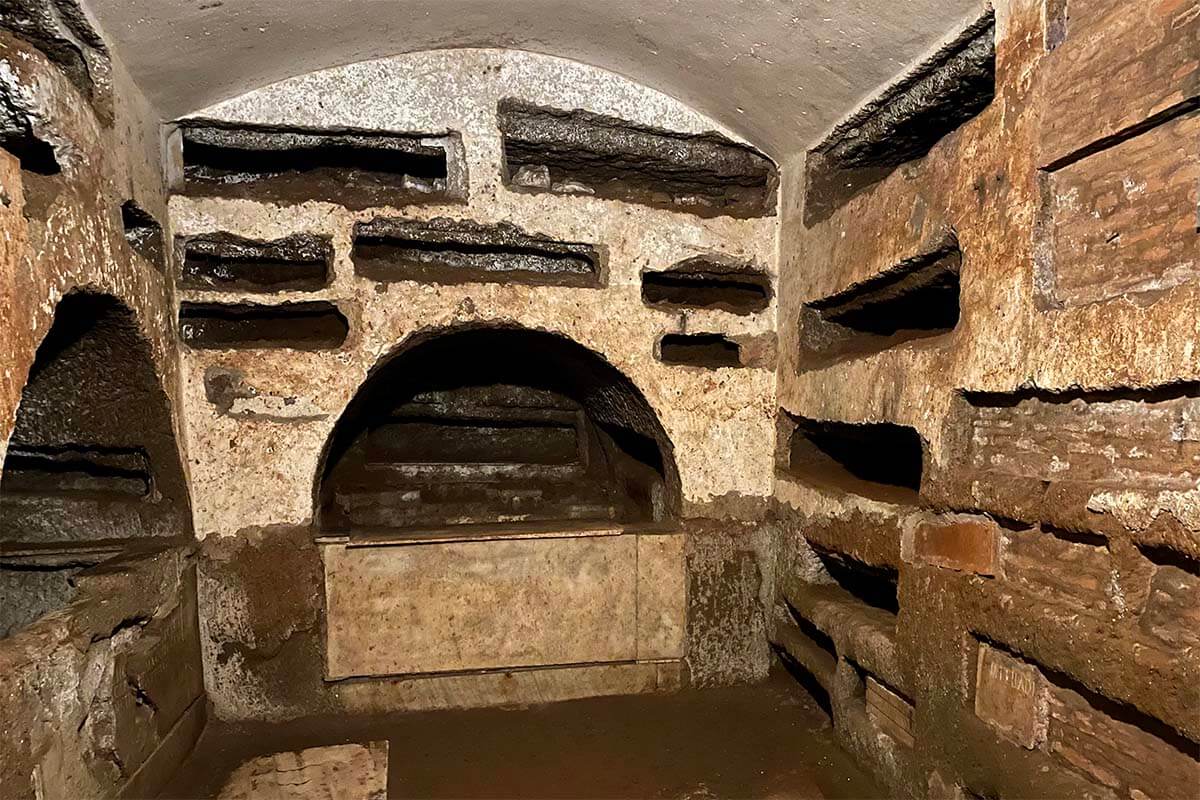
How to visit: You can only visit the Catacombs of St. Callixtus with an official guide (included in your entrance tickets).
You have to make your own way to the catacombs (by car, by bike, or by public transport) and it’s essential to book a tour in advance or you risk not being able to visit. It’s a popular site.
TIP: There are also many guided tours from the city center that include a visit here, usually together with some other ancient sites. We visited St. Callixtus Catacombs with this e-bike tour that also took us to Via Appia and the Park of the Aqueducts.

15. Baths of Caracalla
Built around 212-216 AD.
Baths of Caracalla (Terme di Caracalla or Termae Anthoninianae) is one of my personal favorite ancient sites in Rome. This grand 3rd-century complex with remarkable ruins and some very well restored mosaics is absolutely impressive! You feel so tiny here and it makes you realize how advanced the Romans really were in architecture and engineering.
These public baths were built at the beginning of the 3rd century and were the second-largest bathhouse in Rome. In addition to the luxurious bathing houses, the complex also had several saunas, a sports center, and even an Olympic-size swimming pool. The site was surrounded by beautiful gardens and even had a library.
The baths were heated via a sophisticated underground oven system and you can still see the remains of it today. These Roman baths remained in use for about 300 years. Nowadays, it’s a working archeological site that is open to the public.
Visiting here gives you an amazing insight into yet another aspect of daily life in the glory days of the Roman Empire. And because the Baths of Caracalla are somewhat of a hidden gem and not many tourists come here, this is one of the ancient Roman sites with a more authentic feel.
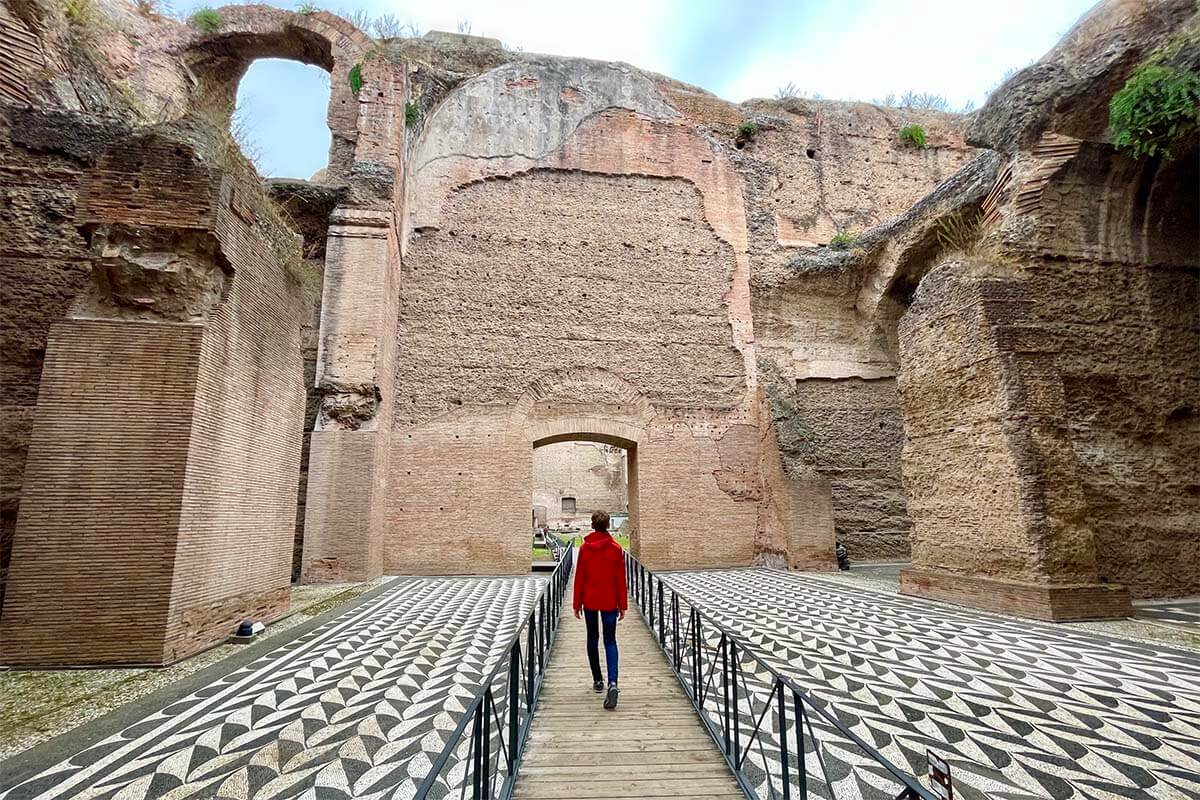
How to visit: The Baths of Caracalla are located a 10-15 minutes walk from the Circo Massimo metro station or about 20 minutes walk from the Colosseum.
You can see some ruins from the outside, but the best parts and the mosaics can only be admired if you actually visit inside.
Normally, you can just get your tickets on the spot. You can find more info on the official website (in Italian).
TIP: The earlier-mentioned guided tour is a great option if you want to visit the Caracalla Baths and Circus Maximus with a local guide.
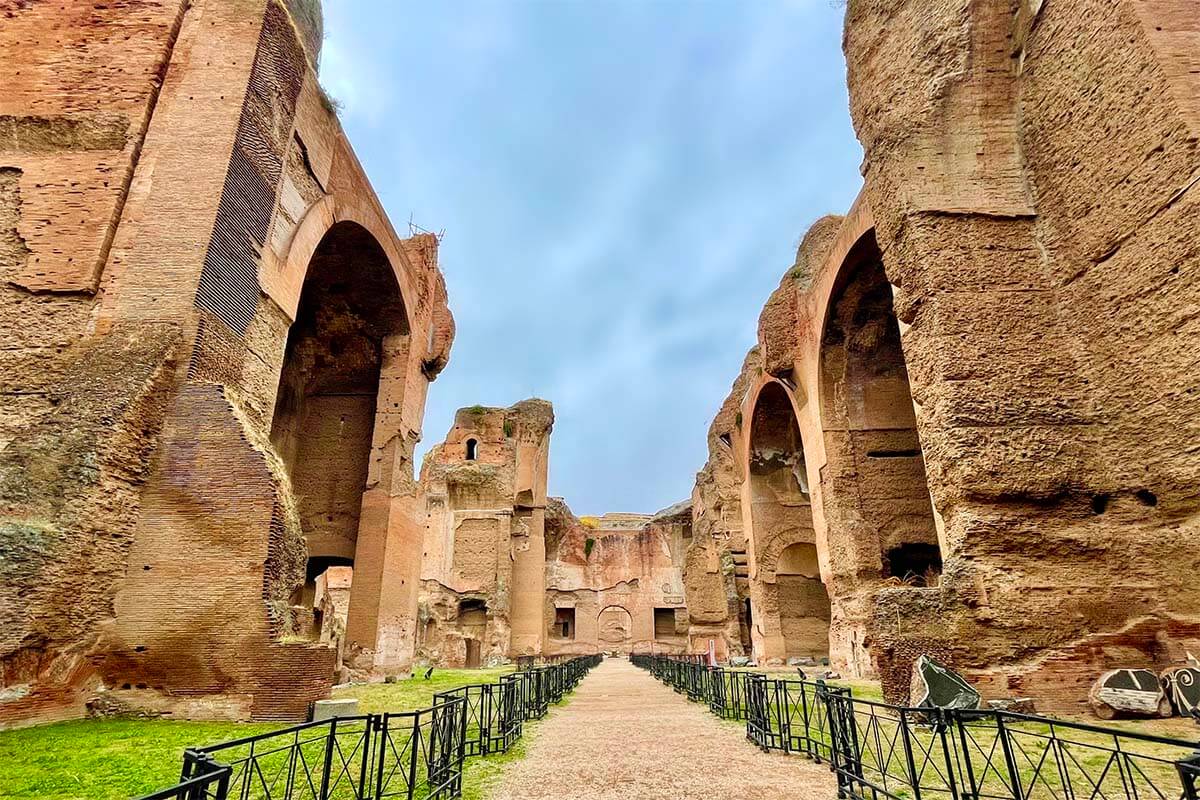
16. Baths of Diocletian
Built around 298-306 AD.
Baths of Diocletian (Terme di Diocleziano) were the largest and most impressive public baths in Rome. The site is just as grand as the above-mentioned Baths of Caracalla, and it also contained several hot and cold baths, but also open-air bathing pools, etc. It’s also believed to have housed a library.
Built at the turn of the 3rd – 4th centuries, the baths remained in use until the 6th century. Over the centuries, the site has been used for various purposes, with lots of construction in and around it shaping the new city of Rome. In the 16th century, a basilica was built here, and later a monastery was added as well. At a certain point, parts of the old bathhouse were used to store and sell grain and oil.
In the late 19th century, the monastery was abandoned. The Roma Termini railway station was built nearby, just as several hotels, palazzos, etc. In 1889, the remaining site of Diocletian’s Baths and the monastery was designated as a museum, part of the National Roman Museum.
This means that the site is quite well-preserved, many of the areas are covered with a roof, there are beautiful sculptures, mosaics, and other Ancient Rome artifacts. It has much more of a museum feel than the Baths of Caracalla, but is well worth visiting too!
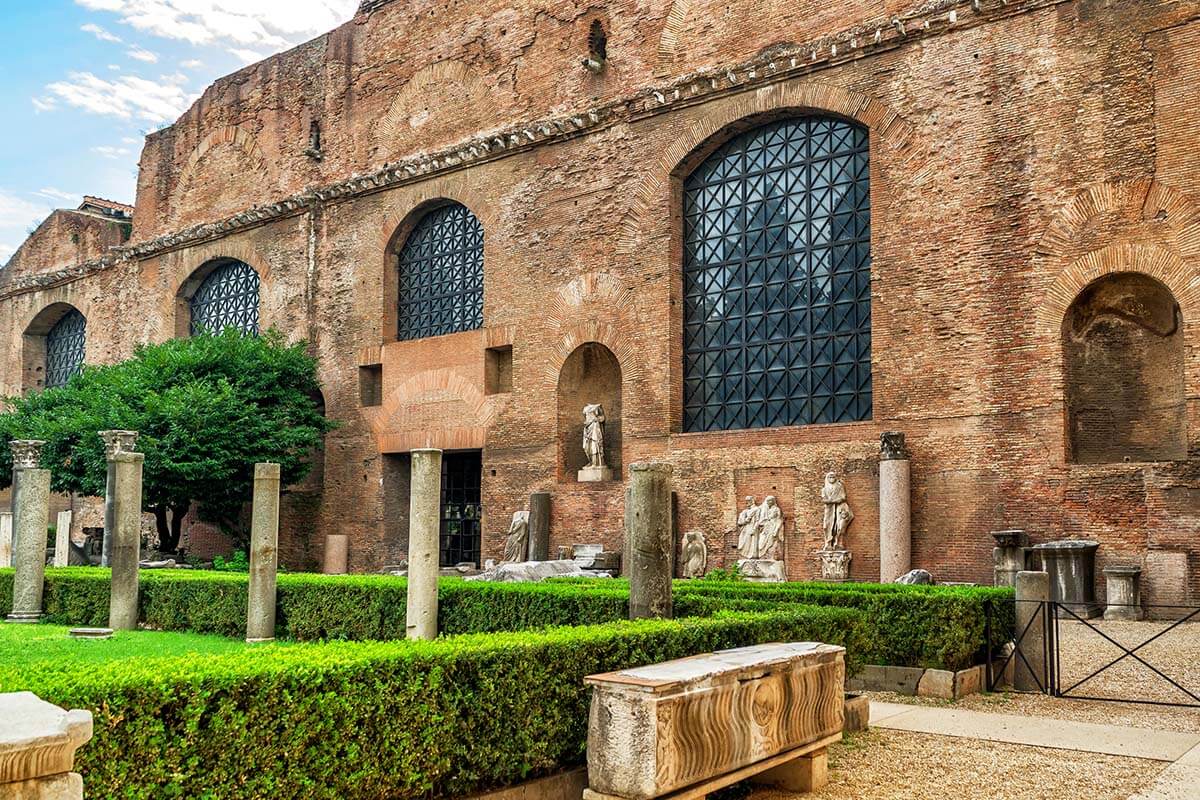
How to visit: The National Roman Museum – Baths of Diocletian section is quite centrally located, just next to the main train station in Rome. It’s normally open daily except on Mondays, and you can just get a ticket on the spot.
TIP: The entrance here is also included with the Omnia Card.
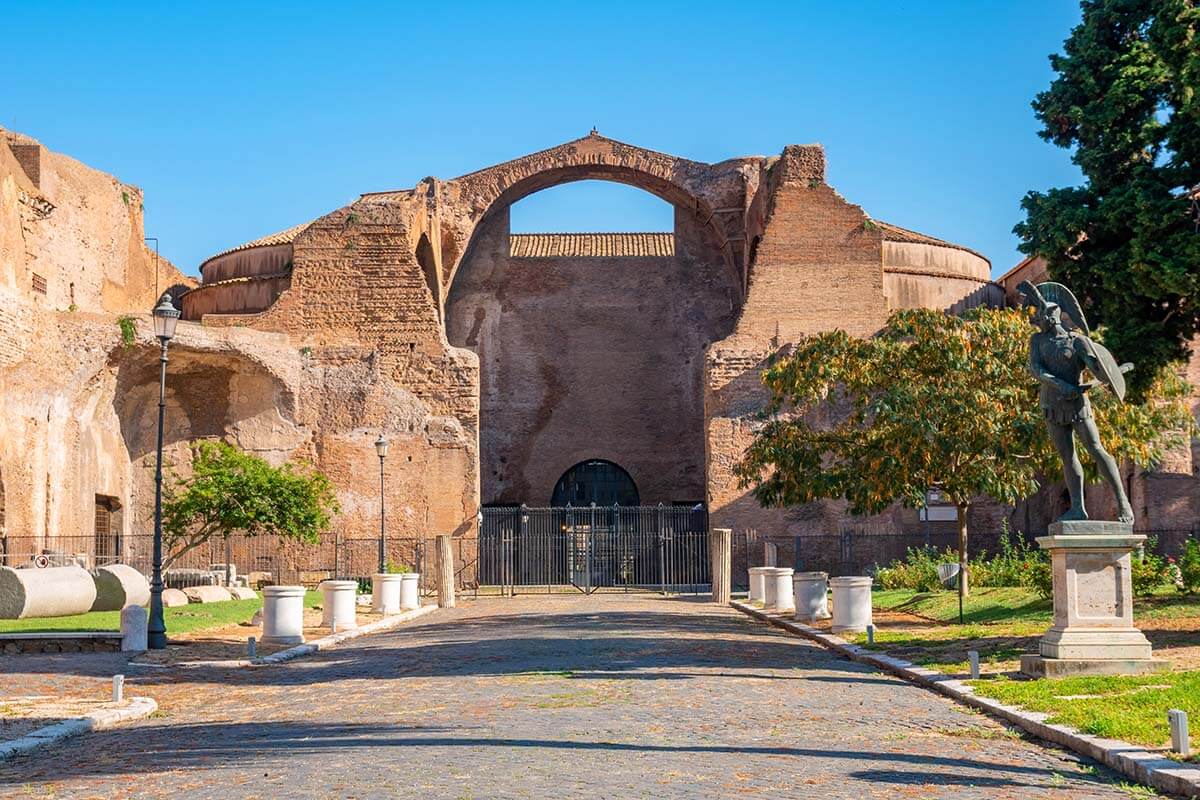
Map of the best ancient landmarks in Rome
To help you get a better idea of where all the sites mentioned in this guide are located, we created a map indicating the best ancient Roman landmarks in Rome.
This should help you plan your visit, and maybe you can include a few of these places in your itinerary when exploring the most popular sights and tourist attractions in Rome.
How to use this map: Use your computer mouse (or fingers) to zoom in or out. Click on the icons to get more information about each place. Click the arrow on the top left corner for the index. Click the star next to the map’s title to add it to your Google Maps account. To view the saved map on your smartphone or PC, open Google Maps, click the menu and go to ‘Your Places’/’Maps’. If you want to print the map or see it in a bigger window, click on ‘View larger map’ in the top right corner.
So, this is our guide to some of the most interesting ancient landmarks to see in Rome. I hope that this gives you a better understanding of when some of the oldest buildings were built, the stories behind the ruins you see, and inspires you to visit at least some of them.
There’s so much history and fascinating ancient sites everywhere you go in Rome, and that’s what makes the Eternal City one of a kind!
For more information and tips for your visit, please also see our itineraries and other guides to Rome via the links below.
Rome Travel Guides:
- Good to know:
- What to see and do:
- How to plan your visit:
- 1 Day in Rome (all the best places)
- 2 Days in Rome (the musts + a few hidden gems)
- 4 Days in Rome (top sights, hidden gems, a few more ancient landmarks)
- … for many more travel guides all over the country, please see our Italy travel guide.
BUCKET LIST: Best Places to Visit in Italy
If you found this post helpful, don’t forget to bookmark it and share it with your friends. Are you on Pinterest? Pin these images!
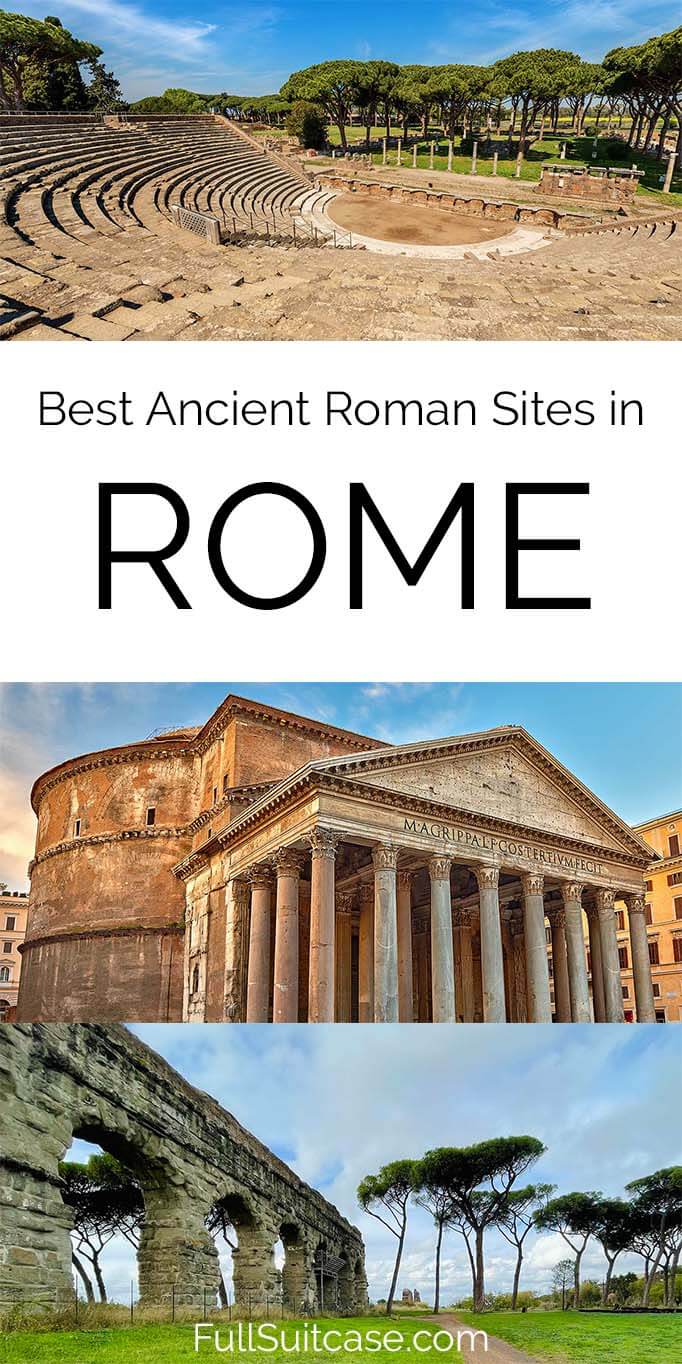
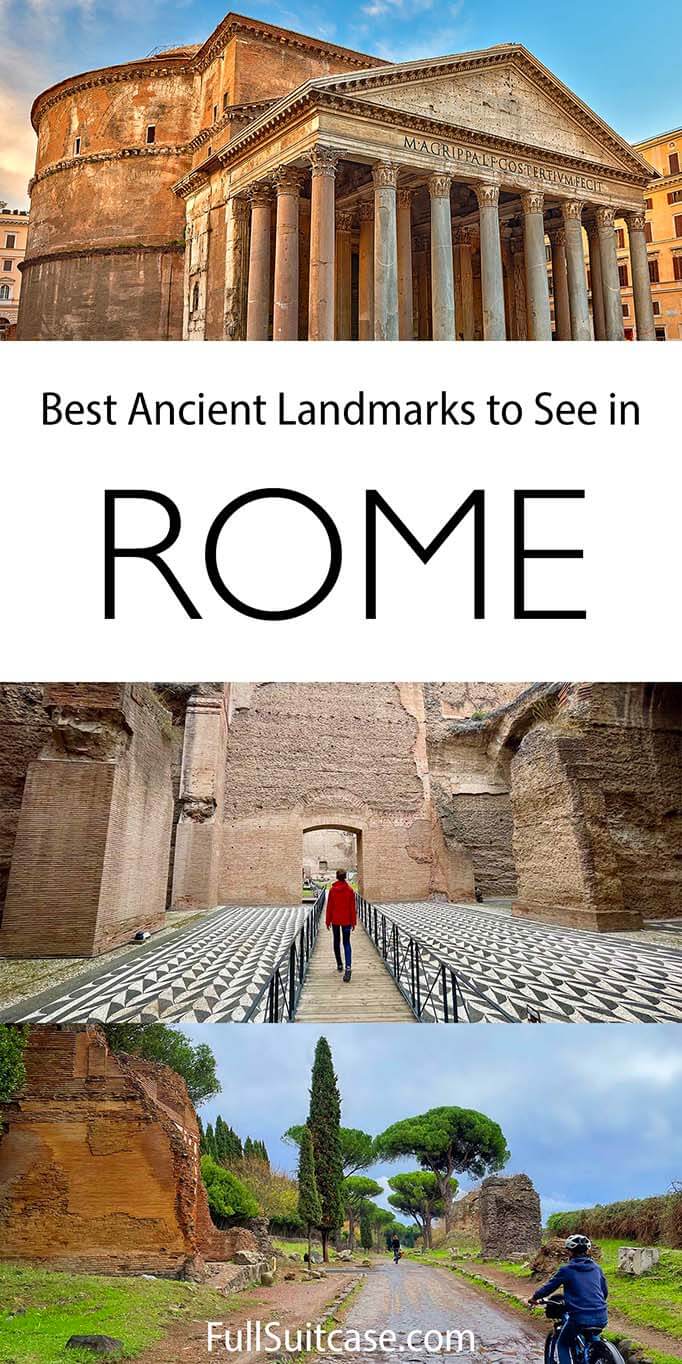
This site contains affiliate links, which means that we may earn a small commission, at no cost to you, for qualifying purchases. More info: Disclosure.



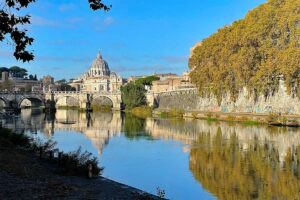


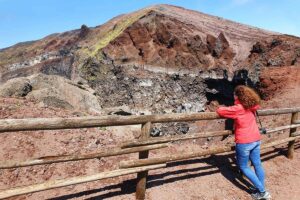
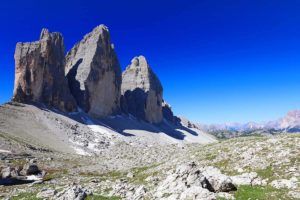
Thanks for this great guide, Jurga. It’s so interesting to also see the timeline of the oldest places in Rome. I always thought that colosseum is the oldest building in Rome and had no idea about so many other places. I will try to visit Ostia Antica too and already booked the Appian Way bike tour that you recommended.
Thanks for the feedback, Evy, and have a great time in Rome!